Love Thy Farmer and All Agricultural Producers
 By Tom Castronovo Executive Editor/Publisher Gardener News
By Tom Castronovo Executive Editor/Publisher Gardener News
Please have patience when it comes to being caught behind large farm equipment on the roads.
The spring planting season is underway, and there will be more
occasions where drivers and farm vehicles share the road. Farm vehicles will also share the road during the fall harvest.
I’ve recently heard several stories
about farmers and other agricultural producers from throughout the Garden State who have reported an increase in accidents or close calls on the roads


April 2024 No. 252 Read the Gardener News Online at GardenerNews.com Gardener News Gardener News Proudly Serving the Agricultural, Gardening, Landscaping & Nursery Communities TAKE
21 ANIVERSARY ISSUE st
ONE
Tom Castronovo/Photo
A Ford Ranger pickup truck uses caution while passing a John Deere 8235R farm tractor pulling an E-Z TRAIL 860 farm wagon on Stuart Road in North Hanover Township, Burlington County, NJ.
(Cont. on Page 18)


Around The Garden
By Tom Castronovo Gardener News
Handsome Like My Dad
This spring I wanted to add a splash of color to the memorial garden that I built for my handsome Dad, during a season that can often be comfortless. I decided on the Helleborus after seeing mass plantings of them at the 2024 PHS Philadelphia Flower Show. The variety I chose is called ‘Ice N’ Roses.’ I decided I wanted some color before the mid- to late-spring blooming daffodil bulbs I planted last fall start to bloom.
This impressive new ‘Ice N’ Roses’ hybrid has blooms facing outwards and upwards.
The variety produces flowers ranging from pinks to greens to reds that bloom before most other plants in the early spring. The ones I chose are red with dark glossy, green, and deeply lobed foliage.
The Helleborus I planted truly enriches the biodiversity of my handsome Dad’s memorial garden. Its unmatched beauty has made it a prized possession in the landscape.
Let me now mention some facts about the Helleborus
The common name hellebore is assigned to several species of plants in the Helleborus genus of the Ranunculaceae family.
Hellebore foliage is thick and forms a low lying clump with foliage that is lobed and palm-like. Hellebores are among the earliest perennial flowers to bloom, welcoming spring with their rose-like blossoms.
Hellebores are very easy to grow in shady conditions where most plants struggle, provided they have some shelter from harsh winter winds and receive sunlight in the winter. The only real maintenance the plants require is a little cleanup of the dried leaves. If foliage is winter-worn, it can be cut back to basal growth in the late winter to early spring before flowering.
Hellebores prefer partial to full shade during the summer months but require more sunlight in winter.
Hellebores grow best in soil that is welldraining and rich with organic matter. If your soil is acidic, consider adding lime, as hellebores prefer neutral or even alkaline conditions. Before amending soil, make sure to do a soil test to determine soil pH levels and nutrient availability.
Hellebores should not be allowed to sit in wet soil for a prolonged time or they will
rot. Once established, they can handle drier soil.
The best time to prune hellebores is in late winter or early spring when new growth begins to appear on your plant. The new growth should come up between the older stems and leaves. Cut the old growth as close to the base as possible.
Hellebores are not bothered by many insects, except for aphids. The common diseases are usually fungal in origin.
Hellebores can be planted in the spring or fall. Blooming might be delayed if the young plant had been forced into bloom too early.
There is one negative component to the hellebore. All parts of hellebores are toxic when ingested, so exercise caution and keep children and pets away. The leaves of a hellebore can cause mild dermatitis and other skin irritation in some people. To prevent problems, wear gloves when handling this plant.
I planted the Hellabores in a hole that was twice as wide as the plants’ rootball and will make sure to water them and plan on watering them regularly, especially during the summer.
I will also not overload the Hellabores with nitrogen when applying fertilizer. Too much nitrogen will cause the plant to produce lush foliage but will leave me disappointed with a shortage of blooms. I’m going to use ferti•lome 10-10-10 this spring. In the fall I will probably use Espoma Organic Bone Meal. I’m a big fan of organics.
Hellebores also benefit from being mulched. Mulch helps to keep the soil moist and cool, which is especially important in the hot summer months. Don’t worry… I’m going to be careful not to pile it up against the stems. My choice of mulch is cedar.
My handsome Dad’s memorial garden is now comforting with deep-red flowers reigning supreme. Let me tell you, they are really stunning with the backlighting of the sun rays through the bones of the woods. After I was finished planting for the afternoon, I looked up into a pine tree and saw a cardinal staring back at me. It was extra especially comforting.
P.S. Hellebores provide some of the earliest nectar and pollen for overwintering pollinators, too.
Editor’s Note: Tom Castronovo is executive editor and publisher of Gardener News. Tom’s lifelong interest in gardening and passion for agriculture, environmental stewardship, gardening and landscaping, led to the founding of the Gardener News, which germinated in April 2003 and continues to bloom today. He is also dedicated to providing inspiration, and education to the agricultural, gardening, landscaping and nursery communities through this newspaper and GardenerNews.com.

GardenerNews.com April 2024 3
Gardener News is published and disseminated monthly. *Whether you are looking to promote your business, a sale or event, celebrate an expansion, enhance your image or maintain relationships with customers, Gardener News can help meet your advertising goals. Germinated in 2003 Gardener News is written by amazing, credentialed industry professionals, industry leaders and brilliant industry specialists. Gardener News covers local, national and regional farming, forestry, horticultural, landscaping and outdoor industry news. We also feature a wide variety of interesting reading material and great educational tips. Gardener News Gardener News is the leading Agricultural, Gardening, Landscaping and Nursery industry publication, both online and in print, in the New Jersey metropolitan area. SIGN UP TODAY for an E-Newspaper Subscription It’sFastandEasy! Please visit the top right-hand corner of www.GardenerNews.com
In 1984, my family moved from a townhome in Willingboro, Burlington County, to a singlefamily home in the Camden County town of Merchantville on a good-sized lot, something we did not have in such abundance at our former residence.
However, the big lot around our new home had a big holly bush and a few trees, but not much more in terms of greenery. My Dad was thrilled! This was a blank canvas. That wide-open lawn gave him immense freedom. And from it, he created his masterpiece.
He contoured the ground, he searched at various nurseries and garden centers for new plants and reliable classics, including my Mom’s favorite, the fragrant lilyof-the-valley, and a tree to which he would later add a swing for his grandchildren. He built gardens that neighbors always admired and remarked upon. This was an amazing lesson for a young lad to learn the value of plants and landscaping to a home.
I’ve often thought about how my father transformed that property when we reach this time of year. Why in April? Because it is the time when we observe both Earth Day and Arbor Day.
While some people mistakenly think that Earth Day and Arbor

NJ Dept. of Agriculture
By Joe Atchison III Assistant Secretary of Agriculture
Earth Day and Arbor Day –Separate But Equally Important
Day are the same, or that one sprung from and replaced the other, they are still two separate and very distinct days in our modern calendar.
Arbor Day clearly has the longevity prize between the two. It was first established in Nebraska by a former newsman turned Senator, J. Sterling Morton of Nebraska, who deemed it should be observed on the last Friday of every April. Morton was among former East Coast residents who settled in Nebraska in the late-19th century and was struck by the state’s lack of trees.
So, Arbor Day became known in some circles as the “tree holiday,” and the preferred way to celebrate it was, obviously, to plant a tree.
Earth Day, established in 1970
by Wisconsin Senator Gaylord to be observed every April 22, has a broader base of things to be honored, and centers more on raising awareness about pollution and taking care of the environment.
As Earth Day and Arbor Day approach, it got me thinking about how both farmers and gardeners can and do contribute to the wellbeing of our planet. In the context of this column, let’s focus on the gardeners.
Plants help clean (actually refresh) our air by taking in carbon dioxide and releasing oxygen. Plants can also absorb toxins from the air and water, making them, to use a more modern frame of reference, like filters or fresheners for those natural elements.
Gardeners can take that work
to help air and water a step further, by reducing the impact on water supplies through establishing and utilizing rain barrels to collect rainwater and storing it for watering their gardens.
Gardeners can also reduce the amount of food waste in our landfills, while at the same time improving our soils, by composting food scraps and turning those things that otherwise would go to the county dump into productive growing matter.
Properly placed trees, shrubs, and other plant materials can help reduce energy costs by shielding your home and decreasing the stress put on the energy grid. And rooftop gardens in urban settings can help alleviate the “heat island” effect of big cities if enough people
get involved.
We lost my Dad in January, but his memory lives on in our hearts and in his gardens, which neighbors still visit to talk about and walk through and share their memories of him.
They say a person’s greatest expression of hope for the future is to plant trees that he could not reasonably expect to sit under.
As Earth Day and Arbor Day come up on the calendar, think about the ways you as gardeners are helping the planet. I thank you and I thank my Dad for all that you do, all you have done, and the positive impacts you provide into the future.
Thanks Pop!
Editor’s Note: New Jersey Assistant Secretary of Agriculture Joe Atchison III is directing the Department, assuming the responsibilities of Secretary, until the State Board of Agriculture’s recommendation for the new Secretary of Agriculture is approved by Governor Phil Murphy. Atchison is also the Director of the Division of Marketing and Development for the department. He can be reached at 609-292-3976.


GardenerNews.com 4 April
2024
for trees, flowers quality, and Garden soil shopping for GROWN know the trees, and flowers for quality, pest free, and the Garden climate and soil
When you’re shopping for JERSEY GROWN nursery stock, you know the trees, shrubs, plants and flowers checked for quality, disease, are pest free, and accustomed to the Garden State’s climate and soil conditions.
Support NJ Agriculture
JERSEY GROWN
Nursery Stock
JERSEY GROWN
Sunflower Birdseed
JERSEY GROWN Firewood
JERSEY GROWN Annuals & Perennials
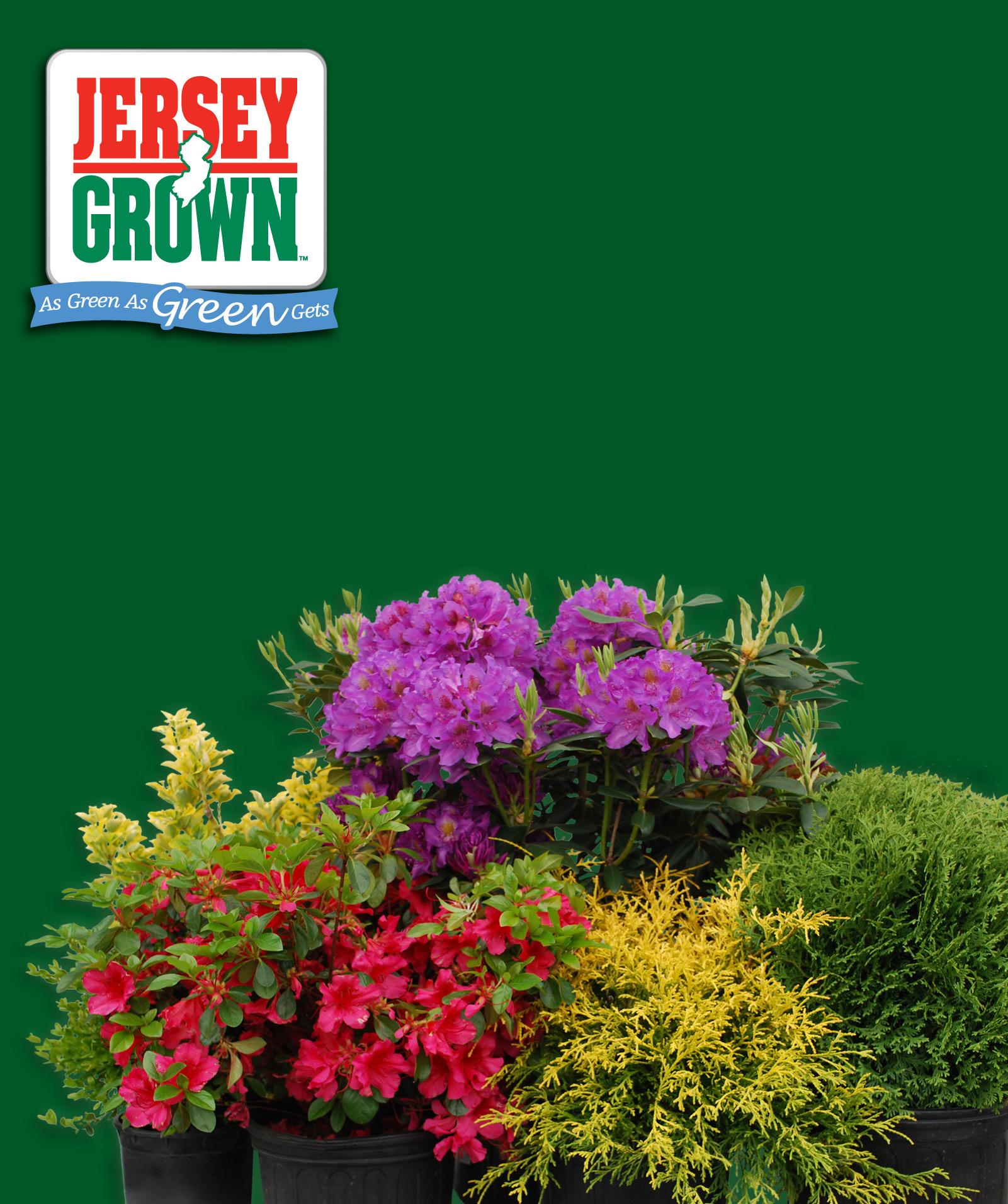
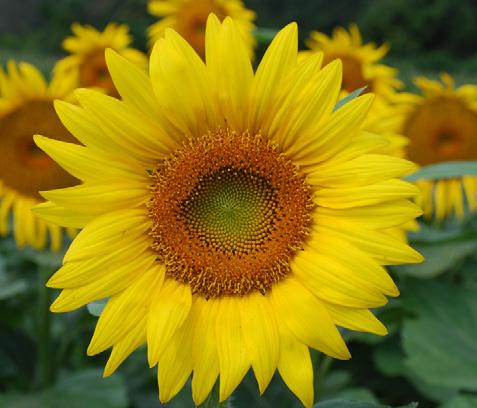





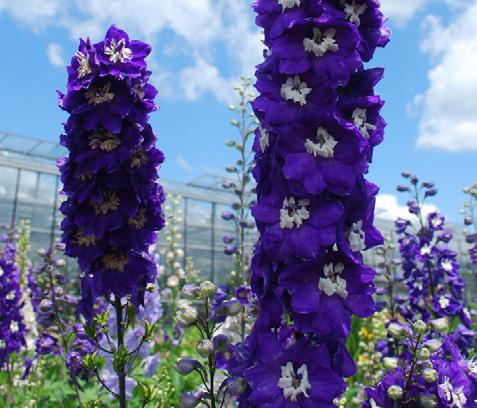
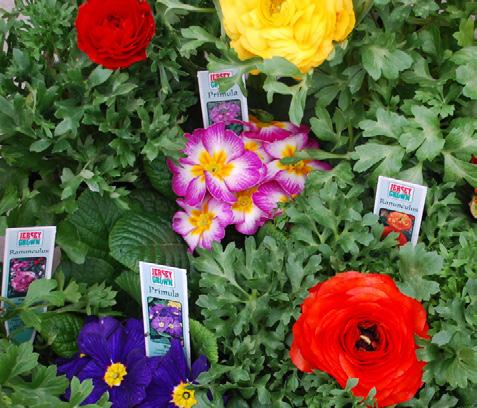


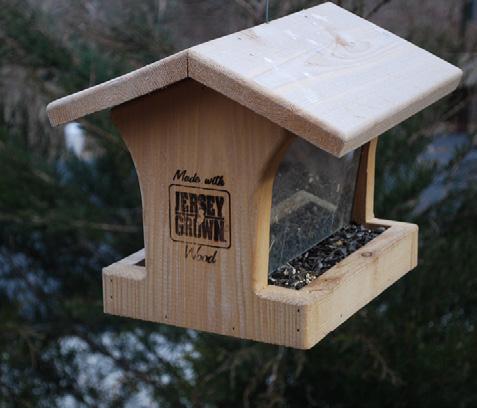


Made With JERSEY GROWN Wood Birdhouses & Bird Feeders Governor
April 2024 5 jerseygrown.nj.gov
jerseygrown.nj.gov
of
III
Phil Murphy Assistant Secretary
Agriculture Joe Atchison
The other day I came across a pamphlet “Livable Ecosystems, A Model for Suburbia.” It was created by Sue Barton at the University of Delaware (circa 2012) and reviewed by the nationally recognized Doug Tallamy.
Barton defines a suburban livable ecosystem as “A landscape that takes advantage of natural processes while providing tangible benefits to the owner.” She continues “When we think of home landscapes as ecosystems, we can start to see opportunities to produce ecosystem services right in our own yards: services such as cleaning water, increasing plant and animal diversity, saving energy, sequestering carbon and enjoying landscapes for the pleasure they can provide.” Ecosystem services “are goods and services received from natural resources contributing directly and indirectly to human welfare.”
Barton identifies four ecosystem services including clean water, fresh air, wildlife, and human wellness. For each service there are multiple benefits and many strategies the homeowner can employ.
For the ecological service, clean water, many benefits such as erosion control, water infiltration, removal of pollutants and recycling and harvesting of water can be achieved. Strategies such as installing a rain garden can be utilized. There are many approaches to rain gardens,

Pennsylvania Horticultural Society
By Andrew Bunting Vice President of Horticulture
Livable Landscapes
but they can be as simple as creating a depressed area that catches water from downspouts or grading can be done in a way that directs the water to these areas. There are many plants that will survive and thrive in wet areas even where there is standing water including the swamp milkweed, Asclepias incarnata; pink turtlehead, Chelone lyonii; marsh mallow, Hibiscus moscheutos; Lobelia cardinalis, cardinal flower and the following shrubs, Cephalanthus occidentalis, buttonbush; Clethra alnifolia, summersweet; and the winterberry, Ilex verticillata
Fresh air is an ecological service that results in a multitude of benefits including lower temperatures, removal of pollutants, carbon sequestration, reduced energy use, etc. These benefits can be realized from strategies such as planting native trees, especially birches, oaks, and maples. By reducing lawn area this will result in more surface area planted with beneficial plants. It will also reduce mowing and therefore
the use of fossil fuels. “Leave the leaves” is a movement to keep leaves and other organic matter on your property. Keeping leaves as a natural mulch will reduce the amount of energy needed to remove them from the curb, plus it adds a great overwintering habitat for many pollinators.
Wildlife brings many benefits to the home garden and landscape. Bees, butterflies, flies, wasps, and beetles are all essential for pollination. Many native birds play a key role in seed distribution and natural predators managed correctly will reduce the dependency on pesticides. Most native plants have ecological benefits and planting native plants will only enhance ecological functions in the garden. Planting a pollinator garden is a great way to immediately create a habitat that will attract wildlife. Some of the best pollinator plants include: Pycnanthemum, the mountainmints; Monarda didyma, beebalm; Asclepias tuberosa, butterfly milkweed; Phlox paniculata, common
phlox; Eryngium yuccifolium, rattlesnake master and the many species of native asters and goldenrods, Solidago. Food sources for the larvae of butterflies should be planted too. The following can be considered including the spicebush, Lindera benzoin for the larvae of Spicebush Swallowtail. Monarchs feed on many Asclepias, milkweed species. The Mourning Cloak feeds on the river birch, Betula nigra; elm species, Ulmus; and the hackberry, Celtis occidentalis. Planting dill, fennel and parsley will provide a food source for the Black Swallowtail.
Finally, the last ecosystem service is human wellness. The benefits include stress reduction, less crime, increased property values, healthy food, a stronger sense of community, and an ability to reconnect with nature. There are scientific studies that show that living in close proximity to a green space reduces both depression and anxiety. These benefits are easily accomplished by
creating beautiful gardens that are engaging and inspiring, and designing gardens that have both functional and usable spaces. Establish enough lawn for recreational purposes, but also evaluate where lawn can be reduced. And, become engaged in the garden. Become a gardener. Learn about gardening and start to develop and create your own home garden.
Editor’s Note: Andrew Bunting is Vice President of Horticulture for the Pennsylvania Horticultural Society. He is one of the most recognized horticulturists in the Philadelphia, Pa., region and a highly regarded colleague in the world of professional horticulture. Bunting has amassed a plethora of awards, including the American Public Gardens Association
Professional Citation, Chanticleer Scholarship in Professional Development, Delaware Center for Horticulture’s Marion Marsh Award, and the Certificate of Merit from the Pennsylvania Horticultural Society. In addition, Bunting has lectured extensively throughout North America and Europe, and participated in plant expeditions throughout Asia and Africa. Learn more at https://phsonline.org/team/ andrew-bunting
Highlights from the Pennsylvania Horticultural Society (PHS) Philadelphia Flower Show “United by Flowers”
Inside the Pennsylvania Convention Center, this year’s Flower Show was in full bloom from March 2 - 10, 2024, bringing together visitors from across the nation to show how gardening connects people and creates community.
The Show gathered the most cutting-edge, renowned landscape architects, garden designers, horticulturists, and florists from around the world to design dozens of breathtaking exhibits that capture the essence of this year’s theme while showcasing the latest gardening trends.
“The PHS Philadelphia Flower Show Cup for Best in Show,” “The Philadelphia Trophy,” and the “Mayor’s Trophy” are among the many coveted awards bestowed. The 2024 exhibitor lineup placed emphasis on highlighting and uplifting garden and landscape designers from a variety of professions, experiences, and specialties, giving them an opportunity to share and showcase their unique perspectives.
“The PHS Philadelphia Flower Show Cup for Best in Show – Landscape” was presented to Apiary Studio, a Philadelphia-based landscape architecture, design and experimental horticultural firm. The firm’s exhibit, “Right of Way,” celebrates highway roadsides as a unifying American experience. The ditches
and embankments along roadsides form a green throughway that unites remnant land across the country and is a place that can help restore habitats and add beauty.
“The PHS Philadelphia Flower Show Cup for Best in Show – Floral” was presented to ARRANGE Floral & Event Design for their stunning and intricate exhibit dedicated to the beauty and cultural significance of the orchid.
The proceeds from the Show provide support for PHS’s year-round work in the Greater Philadelphia region to advance the health and well-being of our shared community. The Flower Show helps fund the thousands of trees PHS plants each year, the design and maintenance of our free public gardens for all, and the support of more than 170 community gardens throughout the region.
Proceeds also provide low-cost programming for people to learn about produce gardening to have access to fresh food, support our partnerships to provide stormwater management solutions, and support our workforce development programs that put many people to work in green jobs.
For a complete list of the 2024 Show winners, please visit https://phsonline. org/the-flower-show/press/news/2024-flower-show-winners (Cont. on
GardenerNews.com
6 April 2024
Page 7)

Hundreds of thousands of dried local stems, dehydrated flowers, preserved blooms, leaves and beautiful painted foliage was used to create this USDA Plant Hardiness Zone Map. The magnificent floral display was created by Jennifer Designs, a wedding and event company from South Jersey. The picturesque visual presentation was the winner of the 2024 PHS Philadelphia Flower Show, Special Achievement Award of the Garden Club Federation of Pennsylvania for unusual excellence, Educational. Winner of the Philadelphia Flower Show Silver Trophy for the floral exhibit with the second-highest number of points, the Society of American Florists Flower Show Award for artistic presentation of flowers, and the PHS Gardening for the Greater Good Award for the exhibit that best exemplifies PHS’s mission, Floral.
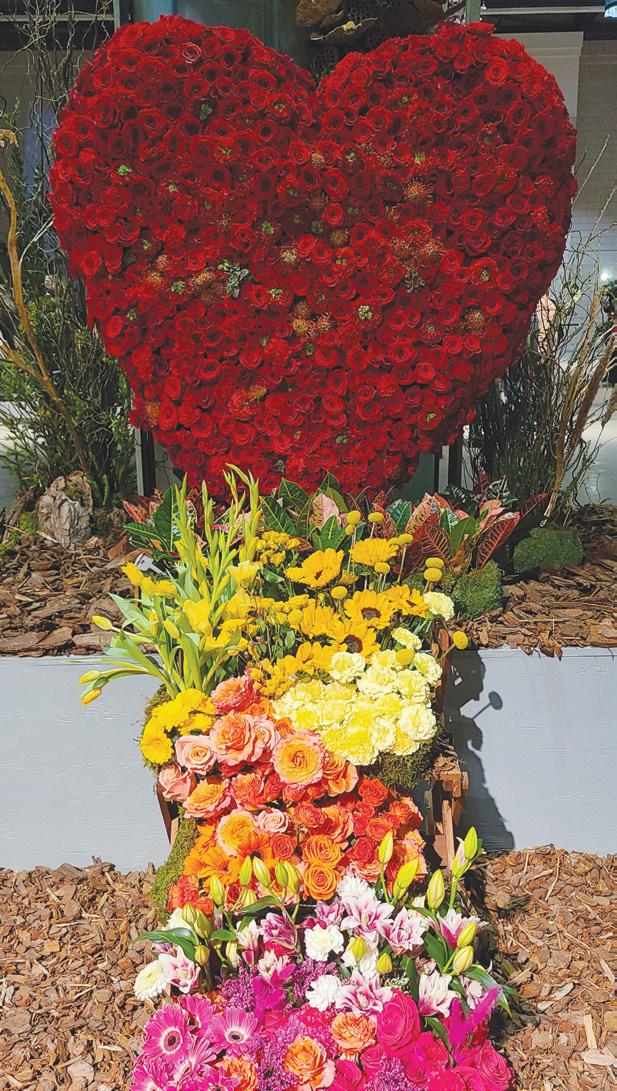
This electric lawnmower from the c.1940’s was on display in the David A. Rubin tool collection at the 2024 PHS Philadelphia Flower Show. The historical exhibition of antique gardening tools also included taskspecific tools ranging in age from the late eighteenth to mid-twentieth centuries, and in origin from France and areas of Europe, the United Kingdom, and the United States.
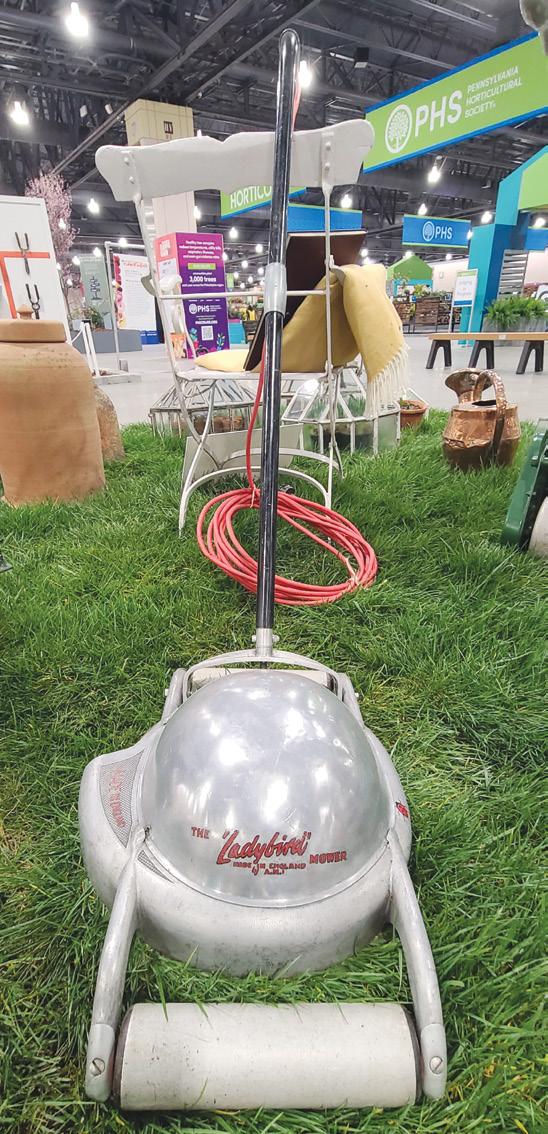

Tom Castronovo, left, Executive Editor and Publisher of the Gardener News catches up with Andre Bunting, VP of Horticulture for the Pennsylvania Horticultural Society. Bunting is also a featured columnist for the Gardener News.
GardenerNews.com April 2024 7
Tom Castronovo/Photos
Love was in the air at the 2024 PHS Philadelphia Flower Show.
By Hubert Ling
Bluets, Houstonia caerulea, can act just like a spoiled child, so why would you want to ‘adopt’ it into your garden? Well, mounds of light blue flowers, suddenly all appearing as if by magic, can really raise your spirits and create anticipation for great things to come from your awakening garden. There is something mystical about bluets and they have been revered by Native Americans and colonists alike.
The genus name honors the botanist Dr. Houstoun and the species name caerulea means sky-blue in Latin. Bluets can appear in nature as a small solitary flower, as a rounded blue mound, or in a few cases as a relatively expansive blue field. But even in a field of bluets, you can sense that something is a bit

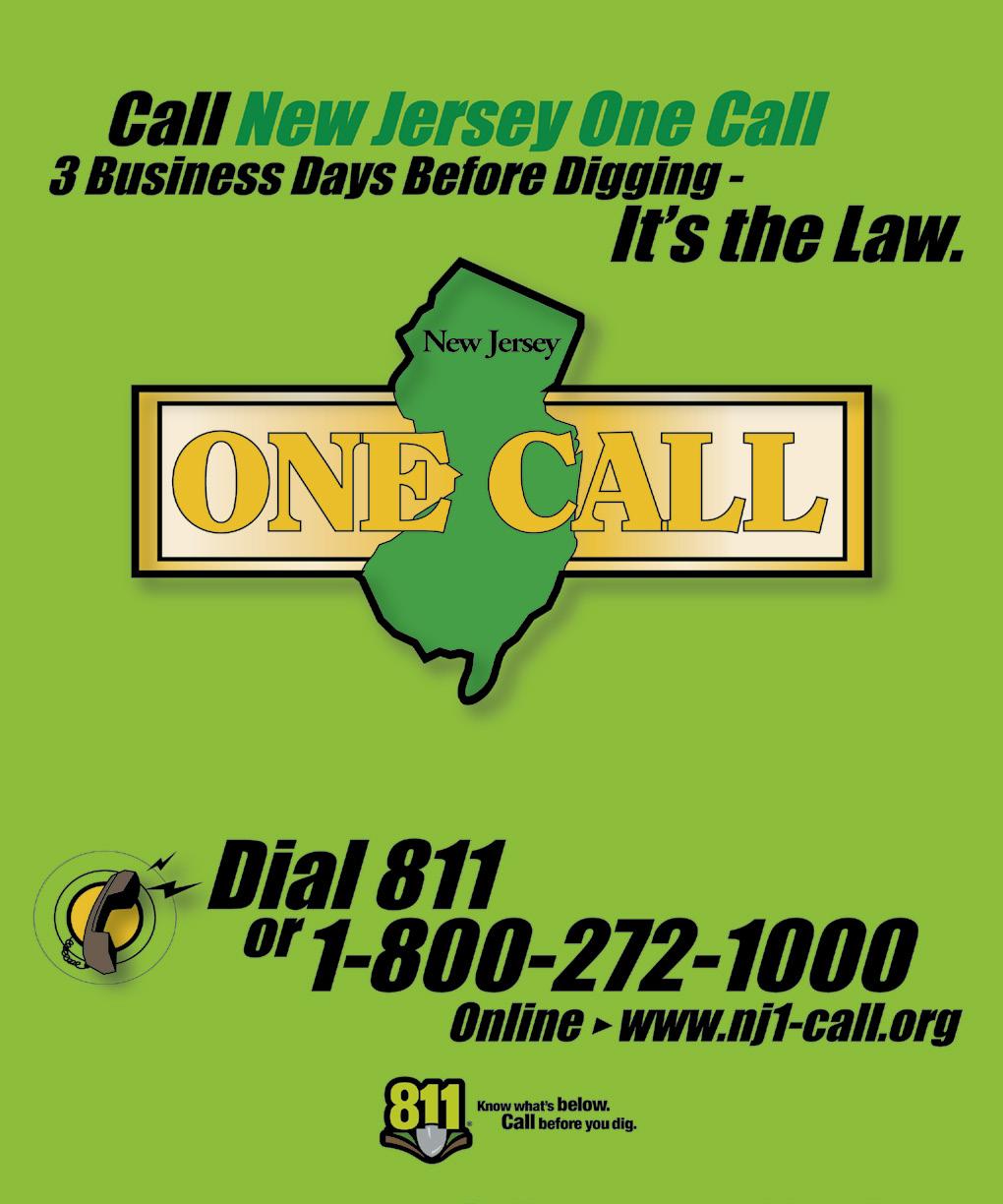
different with this flower. What you will probably see is that there is a patchwork arrangement to the bluets with the mounds limited to slightly higher areas along a lakeside. This may give you a clue that the plant is fussy about growth requirements.
Three comments on bluet culture by experienced rock gardeners are given here:
“I have tried bluets twice, but they disappear after a year or two,” and (It) … “was still alive in the fall but no sign of it this spring.” Also, disconcerting is the statement, “This is the only plant I just can’t get going.”
In the wild, bluets are frequently found in moist areas a foot or two above the water table along lakes. The plants grow in full sun or in light dappled shade in slightly acid soil. Bluets can also be found in well drained rocky areas. These seemingly dry areas may have underground water flowing close to the surface.
I have been growing bluets with varying success for 25 years. I treat them like rock garden plants. They currently reside in two 10 X 24 inch deck planters. In good times these planters are completely filled with about 20,000 pale blue cheerful flowers. When times are bad, I have ten flowers on 20 twisted, sick plants; it’s a bit embarrassing. One year I lightly covered my densely packed healthy bluets with oak leaves for the winter. That resulted in about 99% mortality. It is a good thing that when conditions are right you get complete recovery in six months.
With a wet fall one year I also got 99% mortality by the next spring. I concluded that there was a drainage problem even though the potting mixture had about 50% gravel and sand. I then filled the bottom of the pots with large rocks and gravel with a 3 inch layer of rich soil, gravel, and sand
on the top. Unfortunately, the pots were very heavy and I couldn’t move them easily. Next, I tried filling the bottom of planters with Styrofoam with the 3 inches of potting soil, gravel, and sand on top and used chlorine free water.
That worked well all last year, but early last fall some critters ate all the leaves. Fortunately, regrowth was immediate and I hope to have 20% survival this spring. I’ll now protect the plants with blackberry stems.
I am reporting here for apparently the first time the existence of double bluets. They have eight or nine petals and there is no sign of stamens or pistils. We found them in one location in Massachusetts and reported it to the Native Plant Trust. Bluets have a rich spiritual and medicinal history with Native Americans. These dainty plants generally have four petals (occasionally
five) and are also cherished by gardeners for rock gardens, garden paths, and woodland settings; they are the state wildflower of Maine. The flowers are white to deep blue and about ¼ wide with bright yellow centers. There are two types of flowers, one with protruding stamens and another with a long pistil. Bluets are extensively used by small bees, flies, and butterflies for nectar and pollen.
If you are up to a challenge, consider this lovely plant. For more details and pictures, including the newly discovered double variety, check out our website at https://www. awesomenativeplants.info/
Editor’s Note: Hubert Ling is Horticultural Co-Chair of the Native Plant Society of New Jersey. He can be reached at milhubling@ verizon.net.
GardenerNews.com 8 April 2024
Adopt A Problem Child?
BILL RANDOLPH AGENT 908.782.4028 SERVING THE AGRIBUSINESS COMMUNITY LIFE • PROPERTY DISABILITY INCOME INSURANCE American National is a group of companies writing a broad array of insurance products and services. Products and services may not be available in all states. Terms, conditions and eligibility requirements will apply. Life insurance and annuity products may be underwritten by American National Insurance Company, Galveston, Texas. Property and casualty products and services may be underwritten by Farm Family Casualty Insurance Company, Glenmont, New York. Form 11094 | 12.18 12 Center Street, Chatham, NJ 07928 www.ChathamPrint.com (973) 635-1880 Graphic DesiGn | printinG | Direct mail Establish ed 1978 SUBSCRIBE TO THE Gardener News Please visit the top right-hand corner of www.GardenerNews.com
As we progress into the spring season, it is time to start thinking about managing the size of our fruit crop for the coming growing year. Assuming that we still have a viable crop after the spring frost season, steps have to be taken to not only ensure a quality crop for this year, but to also protect the health of our trees along with setting us up for a good crop next year as well.
Peaches are, generally speaking, a good annual cropper. As long as their buds are not damaged by a winter freeze or a spring frost, a peach tree will have a prolific bloom and set an abundance of peaches every season. They are wind pollinated, which means they do not require bees for pollination. After the trees bloom, tiny peaches will form and then push off any remaining remnants of the blossoms. As the weather warms up, these peaches will grow rapidly and then mature in July and August.
In order to grow peaches of any sort of marketable size, they need to be “thinned.” This means that a number of fruit must be removed from the tree so that the remaining fruit can reach their optimal size. With
I am a huge fan of groundcovers and why shouldn’t I be? They reduce weed growth, slow stormwater runoff, cool the soil, and many support a diversity of pollinators and wildlife! Oddly, I have seen a slow shift away from groundcovers to mulch. Mulch does look tidy, yet pails to the many benefits provided by little championed evergreen groundcovers such as Barren Strawberry, botanically known as Waldsteinia fragarioides.
Waldsteinia is a member of the Rose Family or Rosaceae with around six species. The genus was penned in 1799 by the German pharmacist, botanist, and plant taxonomist Carl Ludwig von Willdenow (1765-1812). The plant honors the Austrian naturalist, Count Franz de Paula Adam von Waldstein (1759-1823) who studied and co-authored a three-volume treatise on the rare plants of Hungary. Coming as no surprise, the first species Willdenow described in honor of Waldstein was a native of Hungary!
Of course, the path to a plant’s name is rarely straight! A native of eastern North America, Waldsteinia fragarioides was initially described as Dalibarda fragarioides in 1803 by the French botanist André Michaux (1746-1802). Michaux

The Town Farmer
By Peter Melick Agricultural Producer
How Much Is Too Much?
most varieties, a six-inch spacing should be left between each peach. I realize that does not sound like much, but consider the fact that this might entail removing as many as ninety percent of the fruit from the tree! If this is not done, the peaches will not mature properly and not be of marketable size. Also, the overcropping will be too much weight for the tree to handle and might cause structural damage to the limbs of the tree.
While there are some chemical growth regulants that are just starting to be used by the industry, by and large, most peaches are thinned by hand. This means that they either have to be picked off one by one, or clubbed or shaken off of the trees. Needless to say, thinning

peaches has been and remains one of the largest expenses a grower faces.
When it comes to thinning apples, growers must take a much more scientific approach.
First of all, there is a great deal of difference among the many apple varieties. Certain varieties tend to be biennial bearers, meaning that their natural tendency is to have a good crop every other year. To mitigate this as growers, we have to regulate the size of the crop load each season because if trees are overcropped, they will produce a huge crop of very small apples. They will then have a very small crop the following year. To get a consistent crop of apples every year, the crop load must be intensely managed every season.
Fortunately, unlike peaches which must be manually removed, apples can be chemically thinned. But this is definitely not a “one size fits all” situation. Apples rely on bees for pollination. So, this means that the weather during bloom can cause an increase or a decrease in the quantity of apples that set after bloom. The problem is that this is not always readily apparent when it is time to make thinning decisions. If you don’t thin enough, you get a big crop of small apples that no one wants to buy followed by a light crop the next year. Take off too many, and you get a light crop this year. Another factor that makes this difficult is that each variety reacts differently to the chemical thinners that we use.
Morris County Park Commission
By Bruce Crawford Horticultural Manager
A Barren Plant with Great Garden Value
traveled throughout Eastern North America in search of exciting new plants from 1785-1796. The genus Dalibarda was first penned in 1753 by the Swedish botanist Carl Linnaeus (1707-1778) and honors the French botanist and physicist Thomas-François Dalibard (17091778). It was not until 1823 when the Austrian botanist and mycologist Leopold Trattinnick (1764-1849) noticed the plant better matched the description of Waldsteinia and altered the genus. The species epithet fortunately remained consistent and is based on the resemblance of the plant to strawberry, botanically called Fragaria. The common name of Barren Strawberry reflects how the plant produces inedible and dry achenes instead of plump berries and appears barren of fruit!
Waldsteinia fragarioides is rare in many parts of its range. The
plants are mat forming, growing from 4-6” tall and spreading by shallow horizontal stems called rhizomes. As noted, the foliage resembles that of a Strawberry with each leaf consisting of three serrate leaflets and reaching an overall size of 2-3” in width and length. Of great benefit to the gardener, the foliage remains attractively evergreen throughout winter, developing bronze overtones during those colder winters. Come spring, bright green new foliage rapidly grows over and conceals the previous year’s foliage, eliminating the need for any spring clean-up or mulching!
The cheery, 5-petaled yellow flowers appear in early to midApril and persist through May. The flowers are ¾” in diameter with each individual petal measuring 2-5mm in width and not touching or overlapping its neighbor. In the
Certain varieties have earlier or later bloom dates, some varieties thin relatively easily, some are very hard to thin and might take multiple treatments. Also, the air temperature and humidity can affect the efficacy of the chemical thinners, meaning what worked last year may not work this year. Plus, at the time of year when this is done, generally speaking, the three weeks after the trees bloom, there is still a pretty high risk of a frost or a freeze, which could really affect the size of the crop!
Think Spring!
Editor’s Note: Peter Melick is co-owner of Melick’s Town Farm in Oldwick and a 10th-generation New Jersey farmer. Peter is a member of the Tewksbury Township Committee, Hunterdon County, NJ. He also served as a director for the New Jersey Farm Bureau and is a past president of the New Jersey State Board of Agriculture. Peter has also been featured on NJN, News 12 New Jersey and on the Fox Business Network.
growth habit are virtually identical to Waldsteinia fragarioides!
center, a prominent boss of around 70 yellow stamens can be seen surrounding 3-7 prominent central pistils.
Interestingly, our native species is not as prevalent in the trade as Waldsteinia ternata, a species native to portions of Russia, China, and Japan. Just as with our native species, it was originally described as Dalibarda ternata in 1806 by the German botanist Christian Friedrich Stephan (1757-1814). The species epithet of ternata means in clusters of three and refers to the three leaflets that compose a leaf. In 1899 the Austrian botanist Karl Fritsch (1864-1934) properly assigned the plant to Waldsteinia For gardeners, the primary difference is the fuller floral appearance this species brings to the landscape from the overlapping and larger 5-7mm wide petals. Otherwise, the foliage, flower and
Both of these species appreciate light shade and are hardy from zones 4-7. In the wild, plants are found on wooded slopes or ledges where soils are well-drained, rich in humus and have a neutral to acidic pH. The plants reach 12-15” in diameter after 10 years and make a great groundcover beneath shrubs such as Lilac or Viburnum, or interplanted with minor bulbs like Snowdrops.
Although barren refers to the absence of fruit, it usually implies a host of unsavory thoughts that do not apply to either of these Waldsteinia species. Requiring little maintenance and far healthier for the environment than a 2” layer of mulch, Barren Strawberry is the most valuable barren plant I have come to know!
Editor’s Note: Bruce Crawford is a lover of plants since birth, is the Manager of Horticulture for the Morris County Parks Commission, and a Past President of the Garden State Gardens Consortium. He can be reached at BCrawford@ morrisparks.net
GardenerNews.com April 2024 9
Rutgers Cooperative Extension Phone Directory
Atlantic County
Phone: 609-625-0056
Bergen County
Phone: 201-336-6780
Burlington County
Phone: 609-265-5050
Camden County
Phone: 856 216 7130
Cape May County
Phone: 609-465-5115
Cumberland County
Phone: 856-451-2800
Essex County
Phone: 973-228-2210
Gloucester County
Phone: 856-224-8040
Hudson County
Phone: 201-915-1399
Hunterdon County
Phone: 908-788-1339
Mercer County
Phone: 609-989-6830

Pond Design,
Middlesex County
Phone: 732-398-5260
Monmouth County
Phone: 732-431-7260
Morris County
Phone: 973-285-8300
Ocean County
Phone:732-349-1246
Passaic County
Phone: 973-305-5740
Salem County
Phone: 856-769-0090
Somerset County
Phone: 908-526-6293
Sussex County
Phone: 973-948-3040
Union County
Phone: 908-654-9854
Warren County
Phone: 908-475-6505


RCE’s Growing Focus on Urban Horticulture
Over the years, this column has often focused on suburban and rural topics, however, urban horticulture is becoming increasingly important to New Jersey residents. Rutgers Cooperative Extension stands committed to supporting residents in urban areas with their horticultural goals and endeavors.
Urban horticulture, a type of agriculture that occurs in urban settings, includes growing plants for food, decoration or products in settings as diverse as city lots to indoor bookshelves! Urban gardens are known for creative landscaping features such as vertical gardens, planting beds in improvised containers, such as kiddie pools, and other creative solutions designed to meet the challenges presented by urban settings.
Initially, integrating horticulture into urban settings was primarily for beautification and mental health improvement for those living in areas removed from nature. The focus then shifted to the impact of urbanization on climate change and efforts such as green roof programs and heat island reduction projects began. Current efforts combine these past goals and reach into the daily lives of urban dwellers in more integrated, impactful ways.
Multiple issues facing New Jersey residents support the need for robust urban horticulture programs including access to fresh, healthy food, air purification, temperature modulation, cultural heritage, and mental wellbeing. Indeed, the importance of urban horticultural programs is growing worldwide. Urban populations are predicted to double within 30 years, and by 2050, 60% of the world’s population will live in urban areas. Integrated strategies for sustainability must be implemented as part of this growth.
There is a range of Cooperative Extension resources available now. Let’s explore a few examples of programs and resources showing
the breadth of these resources.
An example of in-depth educational opportunities is the Garden Education Series, a multisession, online course taught by Rutgers faculty and staff in the Department of Agriculture and Natural Resources and other Rutgers units. The series explores the planning for, purchasing, and production of healthy plants, whether in landscapes, gardens, on balconies or windowsills.
Residents from across the state are learning to grow healthy plants, diagnose problems, apply proper pest management and more. Many participants go on to become Rutgers Master Gardeners while others are happy to have mastered gardening! This series is currently underway for this Spring. The next will begin in the Fall. This and other education opportunities are available through the calendar of events found at https://events. rutgers.edu/njaes/
The Rutgers Master Gardener program is a significant benefit to our statewide community and is quite active in urban areas. Rutgers Master Gardeners volunteer in city parks, schoolyard gardens, senior homes, and community gardens in order to bring plants into the lives of residents. While the Master Gardener designation is a national one, New Jersey’s first Master Gardener program became established in Bergen County – one of the state’s most urban areas! Thousands of hours are contributed to the betterment of our state each year through the dedication of volunteers. To learn how to get involved or become a Rutgers Master Gardener, email NJMG@njaes.rutgers.edu
Whether an experienced or novice grower, there are always questions. Many Cooperative Extension county offices have Master Gardener Helplines that connect residents to an extensive knowledge base. All questions are
welcome, from what to plant to what is eating my plant and everything in between. Indoor plant questions are welcome! Contact information for each county’s Helpline can be found at https://njaes.rutgers.edu/ master-gardeners/helplines.php
A volunteer or staff member will research the question and provide a detailed response. This resource serves thousands of residents throughout the state every year.
Creating small-space, urban gardens requires planning as tight spaces produce additional challenges. There are many Fact Sheets on the Rutgers website that help address issues establishing new plantings and plant care. Fact sheets for a multitude of topics, from specific plant care to disease identification, insect management, turf care and more can be found through the Home, Lawn and Garden page of the Rutgers Cooperative Extension website ( https://njaes.rutgers.edu/homelawn-garden/).
Urban gardens are not immune to disease and pests. The Rutgers Plant Diagnostic Lab and pest identification services are here to help. Residents can bring a piece of the infected plant or insect in a sealed container to their Extension office for identification and receive advice for a treatment plan. High quality photos through email are also a way to reach out for support. Cooperative Extension can also assist with tick identification. Ticks can even be tested for diseases through the Rutgers Center for Vector Biology.
Once gardens are established, urban horticulture support continues through food harvesting, nutrition and wellness programs and resources. The idea of farmto-table is not exclusive of urban areas. This approach for integrating growing into the lives of urban residents includes the full circle of planning, growing, utilizing and recycling plant products.
GardenerNews.com 10 April 2024
From the Director’s Desk Rutgers Outreach Provided by Brian Schilling Director Editor’s Note: This article is written by Ruth Carll, State Leader, Consumer Horticulture and Master Gardener programs, Rutgers Cooperative Extension (RCE). RUTGERS
April 18 & 19, 2024 | 8:30am – 12:30pm EDT Early Bird Fee $375 | Online (Live, instructor-led) Learn More & Register Online at: go.rutgers.edu/pond-design
NJAES/RCE
Management, and Maintenance Learn how to design and maintain a healthy pond, including liners, embankments, littoral benches, aquatic wildlife, nutrient and pollutant removal, and more Biologists Ecologists Engineers Greenskeepers Homeowners Who Should Attend: Landscape Architects Landscape Designers Project Managers Public Works Directors Wastewater Operators *Don't delay; the early bird discount ends April 4 Register early and save $20! This class is a great source of information for pond owners, pond managers, landscape architects, engineers, and anyone involved with the design, management, or maintenance of ponds.
Experience #RutgersDay
Rutgers Day is set for Saturday, April 27, 2024, 10 a.m.–4 p.m. on the Busch Campus in Piscataway and the College Avenue and Cook/Douglass campuses in New Brunswick. Get ready for the ultimate celebration of everything Rutgers!
Taking place (rain or shine), Rutgers Day is a free, annual event open to the public and your chance to get a glimpse of exciting things happening at New Jersey’s state university. With free performances, exhibits, hands-on activities, and demonstrations, Rutgers Day will engage and inform you about the valuable contributions the university makes to the people of New Jersey and beyond.
Cows, and pigs, and horses, oh my! You can see all of our farm animals on the Cook Campus. The animal barns are located on College Farm Road.
You can bring your dog on a leash to the Cook Campus only. Dogs are not permitted on Rutgers buses, except for official guide dogs.
Learn more at https://newbrunswick.rutgers.edu/rutgers-day
2023 NJAES Annual Report Available for New Jersey Stakeholders
The Office of the Executive Dean of Agriculture and Natural Resources, Laura Lawson, is pleased to announce that the 2023 NJAES Annual Report is available online and in print.
The report, “Catalyzing New Jersey for a Healthy and Sustainable Future,” offers snapshots of the research and extension activities of the experiment station over the past year, and highlights the impact of NJAES on the lives of New Jersey residents, communities and businesses. It is organized under four broad categories: Building a Climate-Resilient New Jersey, Empowering Communities with Sustainable Practices, Catalyzing Innovation for a Viable Agricultural Industry, and Developing the Workforce of Today to Meet the Needs of Tomorrow.
View your copy of the report at https://njaes.rutgers.edu/pubs/annualreports/2023_NJAES_Annual_Report.pdf
Announcement from Nicholas Polanin, Chair, Department of Agriculture and Natural Resources (ANR)
I am pleased to announce the following additions to our Faculty within the Department of Agriculture and Natural Resources.
Dr. Janine M. Spies joins us as the Statewide Program Leader, Assistant Professor, County Agent III in Fruit IPM, effective March 1.
Janine received her Ph.D. in Entomology from the University of Florida in 2014, and her M.S. in Entomology from the University of Delaware in 2010. She also holds a B.A. in Environmental Science from the New College of Florida, Class of 2008. After a post-doc at the University of Florida, she spent the past five years as the Research Field Coordinator for the IR-4 Southern Region.
Janine will be coordinating programming and supervising staff delivering IPM scouting, grower education, and adoption of new technologies in fruit production across the state.
I am also pleased to announce that Kate L. Brown joins Rutgers Cooperative Extension, Somerset County, as an Assistant Professor, County Agent III, effective March 1.
For the past three years, Kate has served as the Agriculture and Natural Resources Program Associate in Burlington County, assisting commercial growers in production, improving soil health, addressing on-farm safety, and launched online programming such as the Homesteading Academy to connect with clientele during the height of the pandemic.
In her new role with Somerset County, Kate will be focusing on agricultural viability and on-farm food safety.
Kate received her M.S. in Horticulture from Cornell University in 2022 and a B.S. in Plant Science from Rutgers University in 2018.
We also welcomed Ruth Carll, who joined RCE on January 2 in her new role as the State Program Leader in Consumer Horticulture and Master Gardener Program.
Ruth is an innovative leader in the botanical garden and preservation community, with extensive experience and success in development and expansion of community engagement throughout her career. Ruth has
a Masters Degree in Botany from Arizona State University, and has previously served as an Adjunct Faculty member at Maricopa Community College, Director of Programming at the Desert Botanical Garden, and as Executive Director of the McDowell Sonoran Conservancy (all in Arizona), before most recently as the Senior Naturalist with the Monmouth County Parks System here in NJ.
In her new role here at NJAES/RCE/ ANR, Ruth will provide statewide leadership and collaboration across working groups, stakeholders, and Extension Departments and Specialists in support of improving and expanding consumer horticulture outreach, education, and engagement, including the Rutgers Master Gardener (RMG) program.
This new position within ANR has been part of our Strategic Plan since 2013, and we are very excited to have Ruth join us in this exciting effort.
Please join me in welcoming Janine, Ruth, and Kate to their new roles.
GardenerNews.com April 2024 11 RECYCLE THE Gardener News SHARE IT WITH A FRIEND LAND-GRANT UNIVERSITY NEWS RUTGERS NJAES/RCE
What an amazing show!
The New Jersey Landscape Contractors Association (NJLCA) just wrapped up the 2024 Landscape New Jersey Trade Show and Conference and all I can say is “WOW”! What a fantastic day of friends, old and new, networking, innovative and exciting tools and equipment, and top-of-the-line education!

The NJLCA Today
By Gail Woolcott Executive Director
The Most Successful Trade Show Yet!
This year’s trade show, celebrating its 47th year, held at the Meadowlands Expo Center brought together over 2200 attendees, including exhibitors. The sold-out and expanded trade show floor featured over 155 exhibitors spread across more than 335 booths showcasing everything from landscape and hardscape equipment and materials to nursery stock, heavy and light equipment, industry innovations, and financial and employee services. Attendees came from far and wide, including Massachusetts, Maryland, New York, New Jersey, Pennsylvania, Connecticut and Delaware.
Exhibitors were thrilled as the trade show floor buzzed throughout the day. The classrooms were filled with those eager to increase their knowledge in everything from
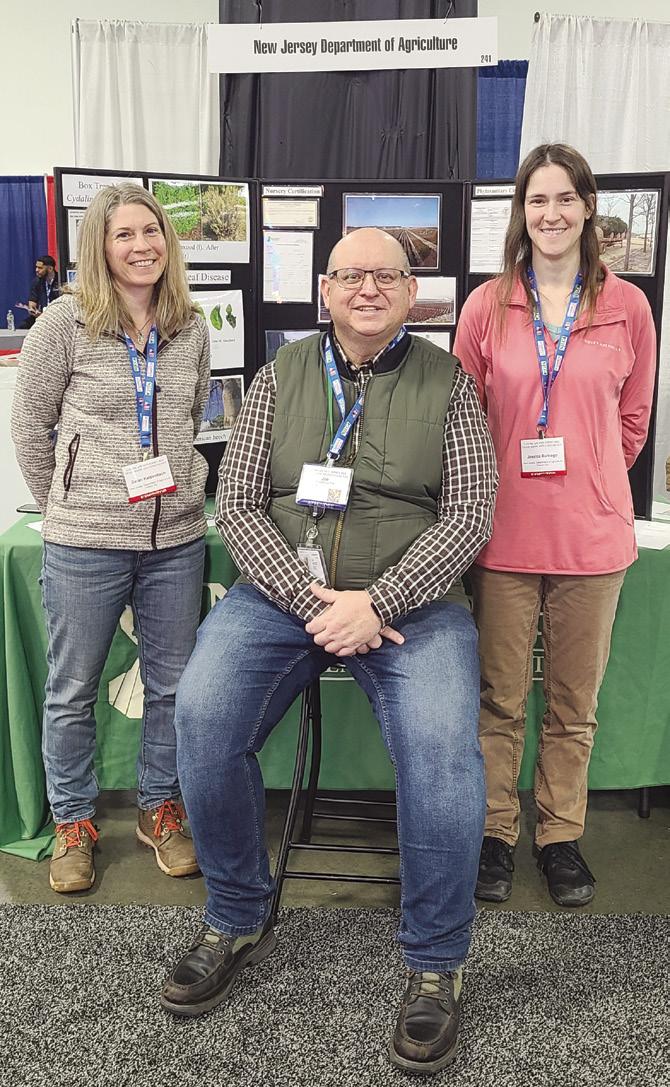
building a business, planning for retirement, and protecting oneself from commercial vehicle and home improvement contractor act violations to tree and shrub pruning, pesticide use and reduction, plant selection, natives, and more. So full were the classes that NJLCA plans to create larger learning spaces for the 2025 show.
Throughout the day, relationships with vendors and colleagues were made and rekindled. In the lobby and in the show, you could hear the frequent exchange of “how are you handling….” And “this is how we accomplish….” The networking and discussions are simply invaluable at the one-day event.
And of course, there are “the toys”! Skid steers, front loaders, tree movers, excavators, mowers, blowers, auto-mowers, “smart” equipment, snowplows, and more were everywhere from all the major manufacturers. It was a feast for the eyes to see some of the latest trucks, trailers, and truck bodies as well. Attendees were able to see the evolution of these machines, featuring enhanced capabilities such as improved fuel efficiency, (Cont. on Page 13)
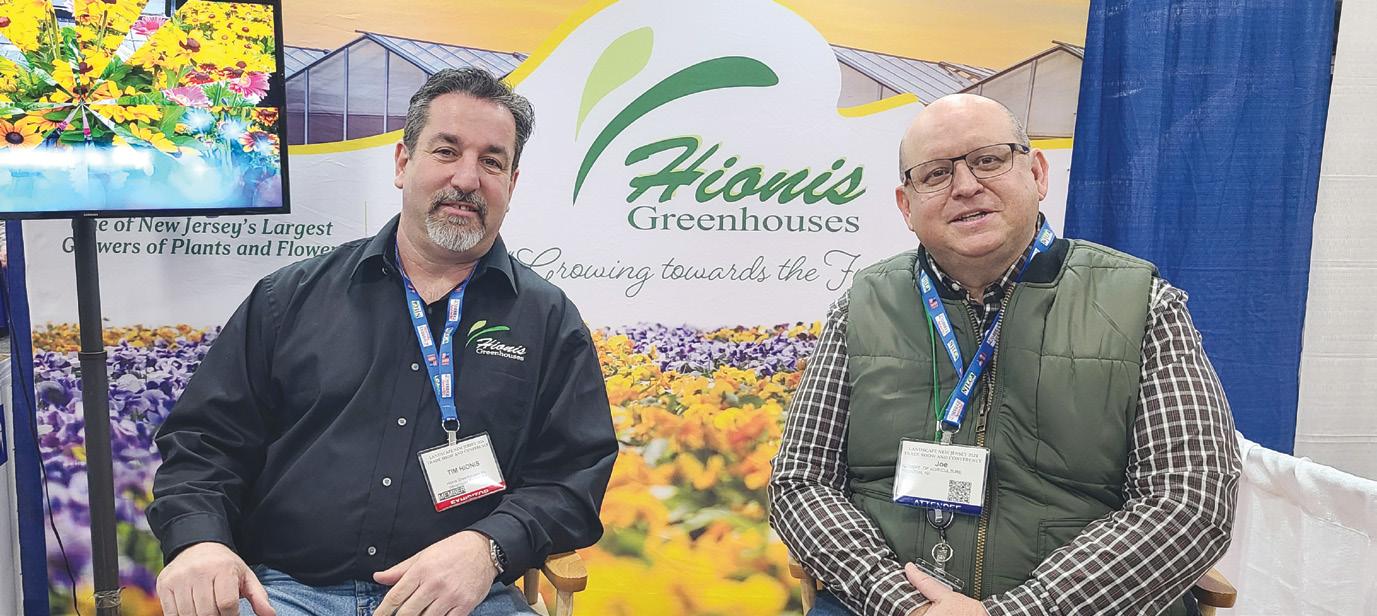

GardenerNews.com 12 April 2024
Tom Castronovo/Photo
A sleek stainless steel BOSS DTX snow plow greeted contractors outside the front entrance of Landscape New Jersey 2024. With rust and corrosion resistance, the stainless steel material helps repel sticking snow, making plowing jobs easier. Boss Snowplow is a division of the Toro Company.
Tom Castronovo/Photo
N.J. Assistant Secretary of Agriculture
Joe Atchison III, right, chatted with Tim Hionis from Hionis Greenhouses about “Jersey Grown” annuals and perennials in the Hionis Greenhouses booth.
Tom Castronovo/Photo
N.J. Assistant Secretary of Agriculture
Joe Atchison III, center, stopped by the New Jersey Department of Agriculture’s Division of Plant Industry booth to say hello to Sarah Katzenbach, left, and Jessica Buitrago.
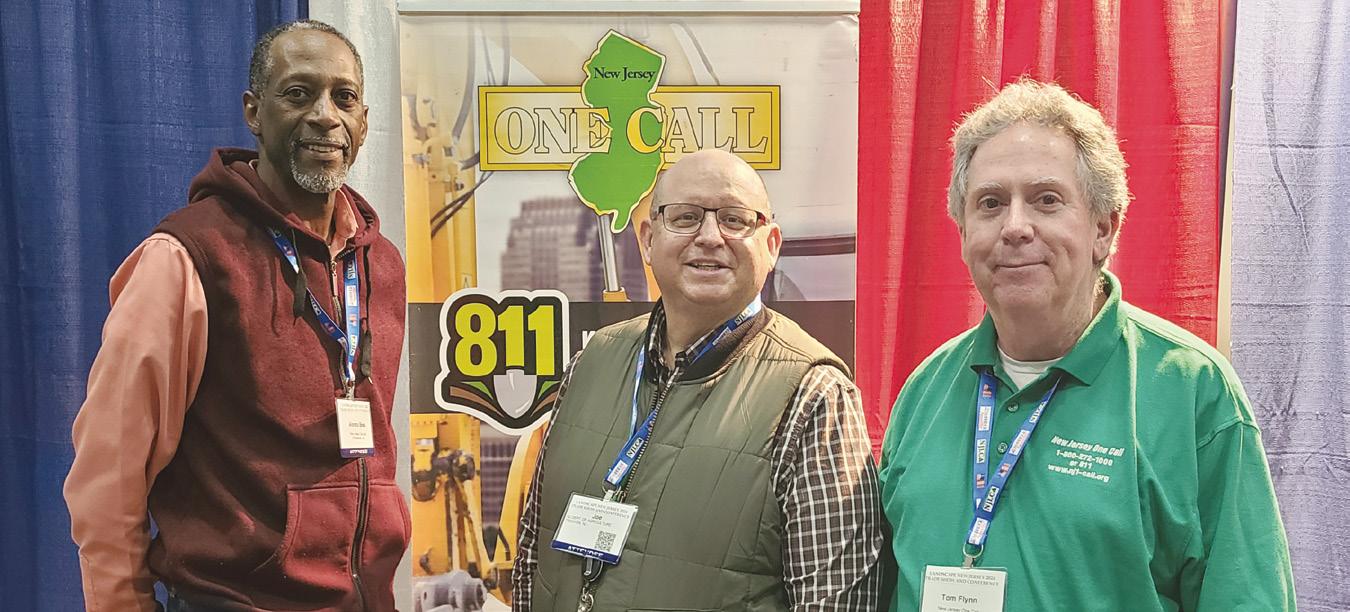
The Most Successful Trade Show Yet!
(Continued from page 12)
advanced automation, and better ergonomics for operators.
Furthermore, precision and power are most important in the outdoor living industry and the selection of innovative and state-of-the-art weed eaters, edgers, saws, and blowers were available to view on the floor.
Alongside machinery and equipment, the show also spotlighted the latest materials and supplies revolutionizing landscape and hardscape practices. This includes sustainable alternatives like recycled materials, solar options, and modular construction components designed to streamline assembly and reduce waste.
It was an immense success all around and I have to take the opportunity (Cont. on Page 15)
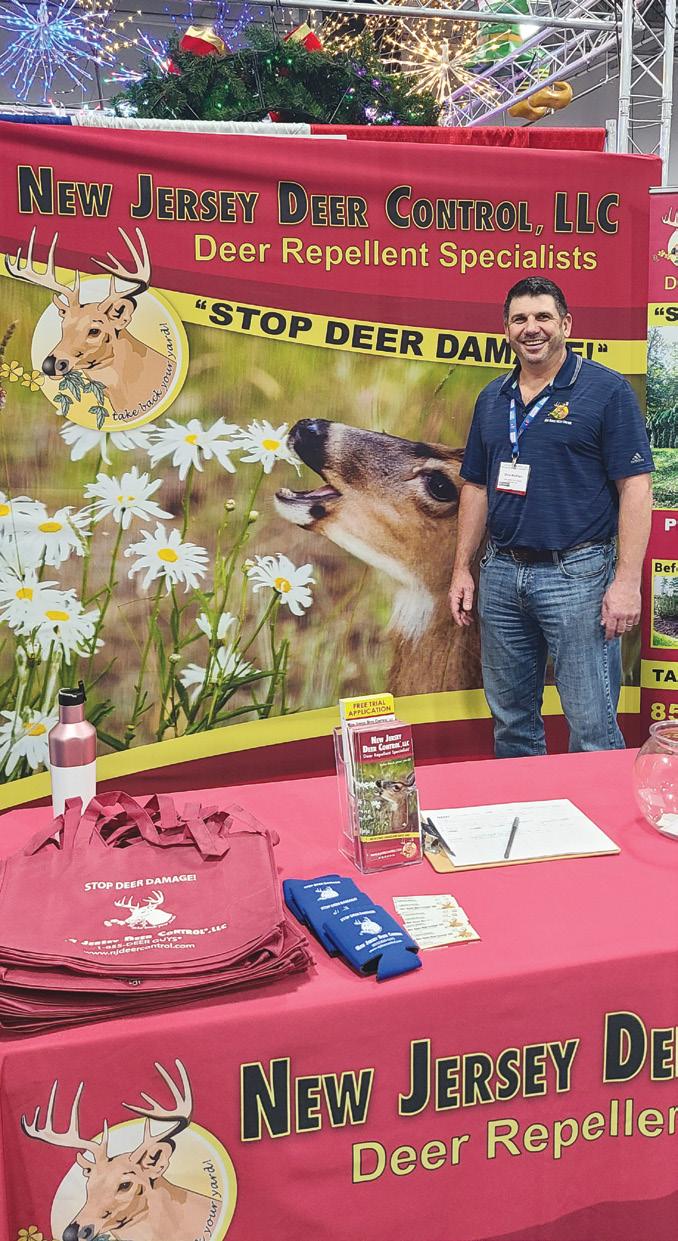
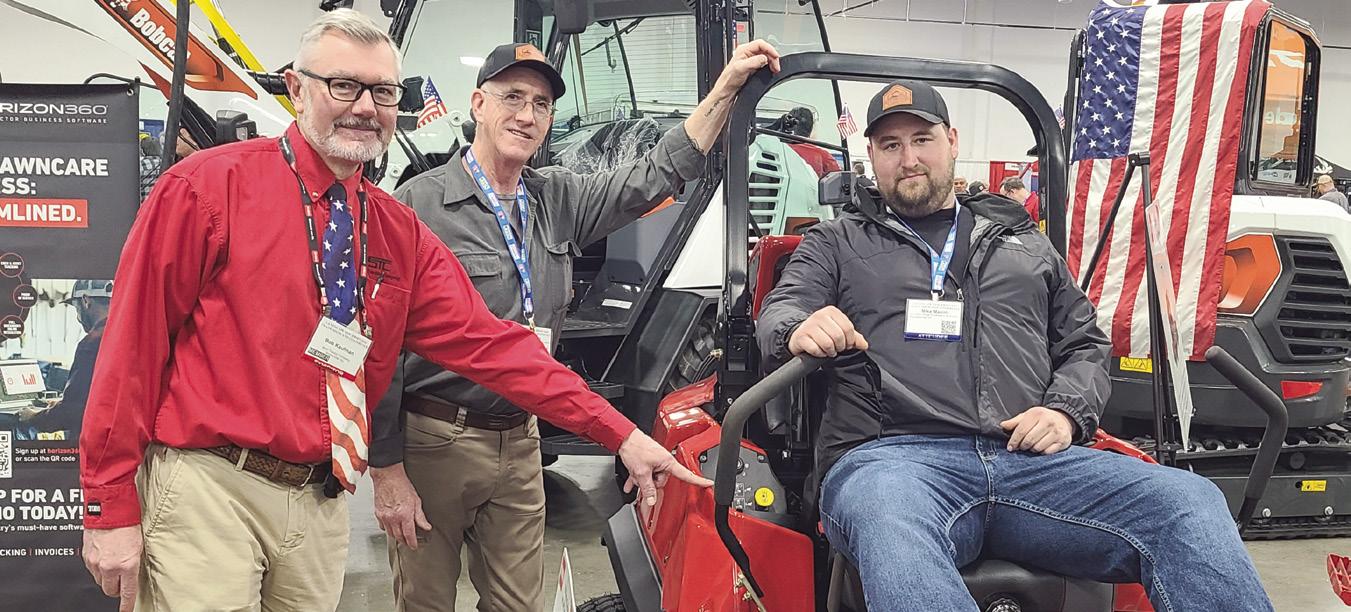

GardenerNews.com April 2024 13
Tom Castronovo/Photo
Bob Maxim, center, and Mike Maxim, right, from Mountain Ridge Excavation & Construction located in Margaretville, NY, looked over a Toro 96” ZMaster 7500D as Bob Kaufman from the Storr Tractor Company explained to them that the machine can mow approximately 10 acres per hour.
Tom Castronovo/Photo New Jersey Deer Control President and Founder Chris Markham, who is also a wildlife biologist, a was on-hand to discuss his proprietary deer repellent and the importance of protecting the landscape with his weather resistant, virtually odorless and transparent product, which is environmentally safe, harmless to humans and pets, and will not damage your trees, shrubs or flowers.
Tom Castronovo/Photo
N.J. Assistant Secretary of Agriculture Joe Atchison III, center, had a conversation about the state of the landscape and nursery industry with Anthony Luciano Jr., left, and Nick Dansen, in the Condursos Garden Center and Market booth.
Tom Castronovo/Photo
N.J. Assistant Secretary of Agriculture Joe Atchison III, center, learned about the importance of calling 811 before you break ground in New Jersey from Alonzo Bess, left, and Tom Flynn in the New Jersey One Call booth.


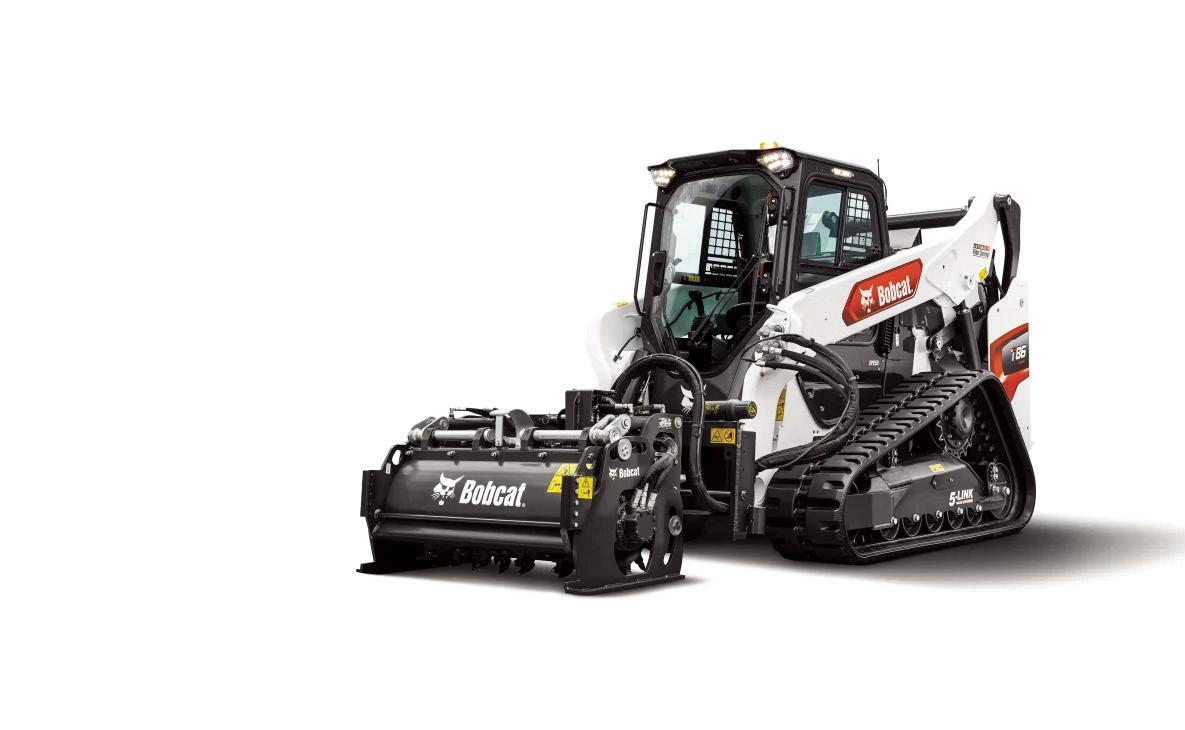

GardenerNews.com 14 April 2024 201 Maltese Drive, Totowa, NJ www.njbobcat.com • (973) 774-9500 Proudly Supporting the Entire New Jersey Agricultural, Gardening, Landscaping and Nursery Communities. THE T86 LOADER Bobcat® T86 compact track loaders set new standards for productivity, attachment versatility, speed, control and weight-to-horsepower ratios. Considering an equipment purchase in the future? Purchasing or leasing Bobcat equipment may be more affordable than you think. INTRODUCING of Nort h Jersey Bobcat of North Jersey 201 MALTESE DRIVE TOTOWA , NJ (973) 774-9500 http://www.njbobcat.com Bobcat , the Bobcat logo and the colors of the Bobcat machine are registered trademarks of Bobcat Company in the United States and various other countries. ©2021 Bobcat Company. All rights reserved. 14520937 Bo B cat .com/Large e xcavators When your work calls for big performance and productivity for difficult jobs, step into new large excavators from Bobcat. Sometimes, bigger challenges demand a bigger excavator. New Bobcat ® large excavators will measure up and then some. Available of Nort h Jersey Bobcat of North Jersey 201 MALTESE DRIVE TOTOWA , NJ (973) 774-9500 http://www.njbobcat.com Bobcat , the Bobcat logo and the colors of the Bobcat machine are registered trademarks of Bobcat Company in the United States and various other countries. ©2021 Bobcat Company. All rights reserved. 14520937 Bo B cat .com/Large e xcavators When your work calls for big performance and productivity for difficult jobs, step into new large excavators from Bobcat. Sometimes, bigger challenges demand a bigger excavator. New Bobcat ® large excavators will measure up and then some. Financing Available our Sales Specialists Barckett 201-446-0127 Patrick.Barckett@NJBobcat.com 201-788-4838 CraigD@NJBobcat.com 973-800-5097 Steve.Caputo@NJBobcat.com 973-800-7109 Sean.Kunkel@NJBobcat.com SEE EQUIPMENT! TOUCH EQUIPMENT! OPERATE EQUIPMENT! TRY US OUT AT THE SHOW! Save the Date Wednesday, August 7, 2024 Visit NJCSE.com for Show Information
The Most Successful Trade Show Yet!
(Continued from page 13)
to thank all of our exhibitors, sponsors and attendees for helping the Landscape New Jersey show continue to thrive and grow. We are so happy to be able to produce an event that not only provides attendees the opportunity to see and check out the latest outdoor living industry innovations but also connect and reconnect with other like-minded businesspeople who can collaborate and share ideas for a better and more professional industry.
Landscape New Jersey will be back on February 26, 2025, at the Meadowlands Exposition Center.
Next up for NJLCA is our “Tony Defeo
Annual Pizza Night,” several more membership meetings and of course our summer show, New Jersey Contractors Showcase Expo where attendees can not only see, but test out much of the equipment and services available at Landscape New Jersey! We hope to see everyone at an upcoming NJLCA event and learn how the association helps businesses and the industry continue to grow and succeed.
But first, let’s celebrate that spring is here, the flowers are in bloom, the smell of fresh grass is back, and the warm days are coming. Wishing you all a wonderful season of rebirth, growth, and plants everywhere!


Editor’s Note: Gail Woolcott is the Executive Director for the New Jersey Landscape Contractors Association. Gail received the New York State Turf & Landscape Association 2022 “Person of the Year” award on December 1, 2022. Gail also received a proclamation from the Westchester County, New York Board of Legislators proclaiming December 1, 2022 as “Gail Woolcott Day” in Westchester County. Gail has also been presented with a community service award from the Borough of Fairview, New Jersey for her assistance in leading the 9-11 Memorial Park project and the Legislative Champion of the Year award from the Federation of Employers and Workers of America. She can be reached at 201703-3600 or by emailing gwoolcott@njlca.org.
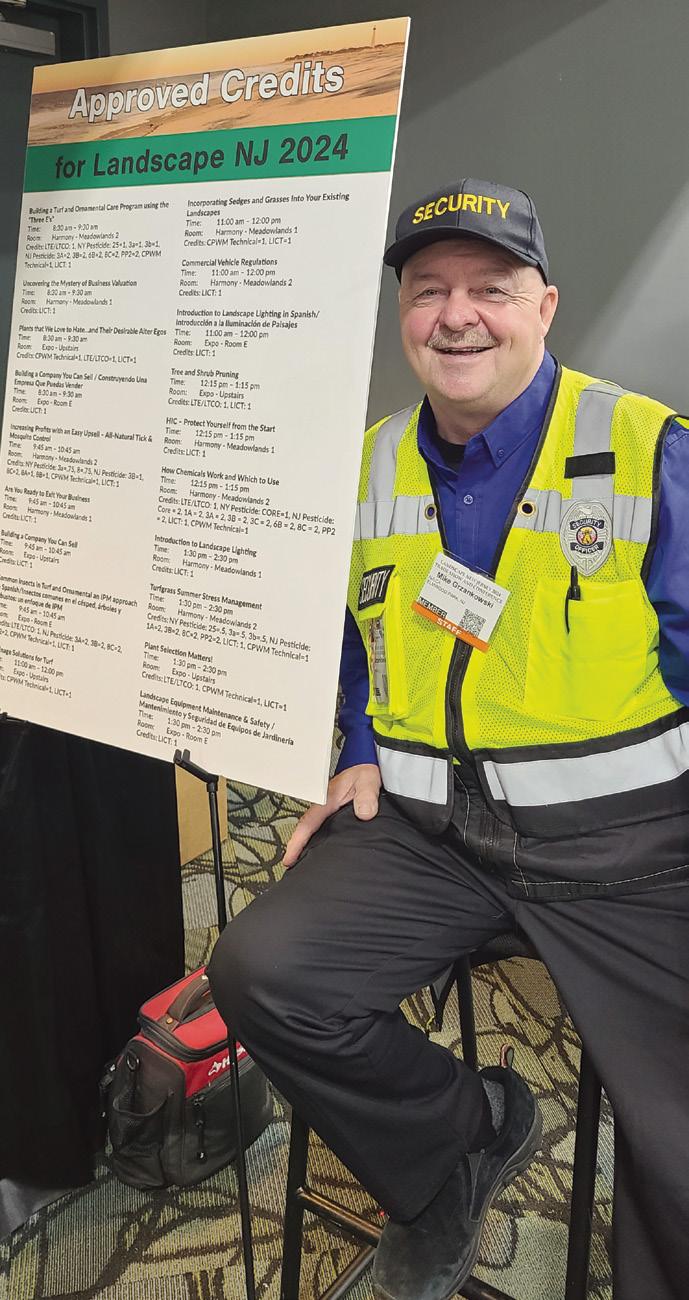
GardenerNews.com April 2024 15
Tom Castronovo/Photo
Mike Grzankowski, the NJLCA show security officer, greeted attendees and answered questions on the location of exhibitors and the educational classes at the front entrance of the trade show floor.
Tom Castronovo/Photo
N.J. Assistant Secretary of Agriculture Joe Atchison III, second from left, talked about “Jersey Grown” shrubs and trees with Tony Cerbo, left, Tyler Cerbo, second from right, and Anthony Cerbo, in the Cerbo Family of Companies booth.
Tom Castronovo/Photo
N.J. Assistant Secretary of Agriculture Joe Atchison III, looked over a Bobcat E35 R2-Series mini excavator as Chris Ryan from Bobcat of North Jersey explained the details of the machine to him.

GardenerNews.com 16 April 2024
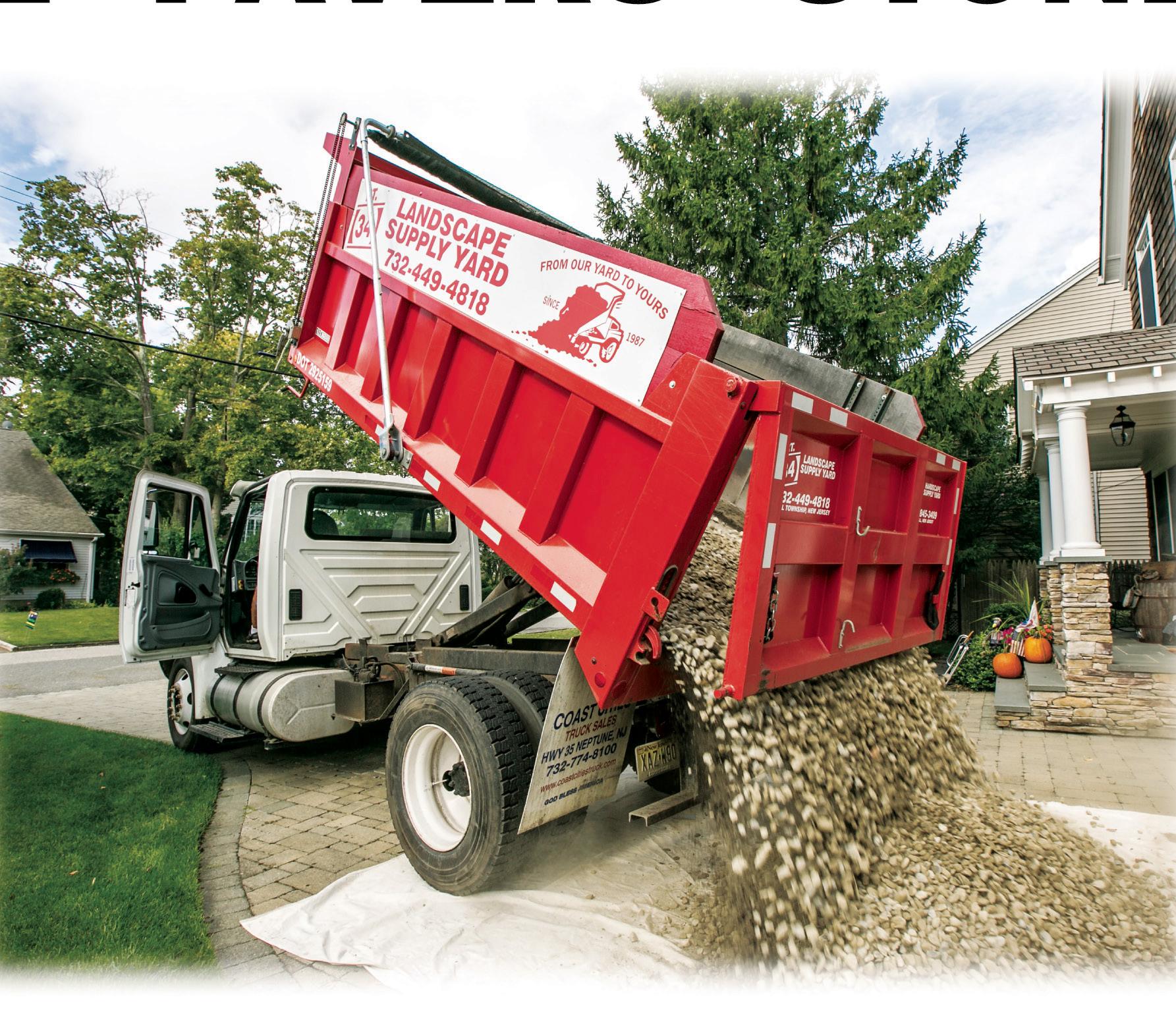





GardenerNews.com April 2024 17 Happy 21st Anniversary “Gardener News” IF YOU ARE INTO THIS . . . Jocko • Huberman Lab • Ryan Holiday Ryan Hawk • Goggins • Bedros • #75hard #themurphchallenge • #@ryandrobbins . . . YOU’LL BE INTO US! Call or stop into: WE’RE HIRING! Yard Help (forklift and wheel loader experience) CDL and Non CDL dump truck drivers PT seasonal (perfect retirement secondary job) Mulcher Culture • Mulcher Mindset Let’s go! Cinco




18 Hamilton Rd., Hillsborough, NJ 08844

Love Thy Farmer and All Agricultural Producers
from drivers trying to pass around their farm equipment.
I’ve also been told that there appears to be a lack of understanding of the motor vehicle regulations regarding interactions among motorists and those driving farm equipment or other slow moving vehicles on the roads.
After a bit of research, I learned that any slow moving motor vehicle, not for hire, used exclusively as a farm tractor, traction equipment, farm machinery, or farm implement and any farm tractor, traction equipment, farm machinery, or farm implement drawn by a motor vehicle is required to affix a slow moving vehicle emblem to the rear of the vehicle when operated on the roadways of the state. The emblem shall be triangular-shaped, red and fluorescent orange not less than 16 inches wide and 14 inches high and centrally affixed to the rear of the vehicle, two (2) to six (6) feet above the ground, measured from the lower edge of the emblem.
This is the New Jersey slow moving motor vehicle law that was provided to me during my research. 39:3-24.4 Reduction in speed relative to approaching slow moving vehicle; violations, fine.
5. a. The driver of a motor vehicle traveling in the same direction as and approaching a slow moving vehicle shall, prior to overtaking the slow moving vehicle, reduce the speed of the
(Continued from page 1)
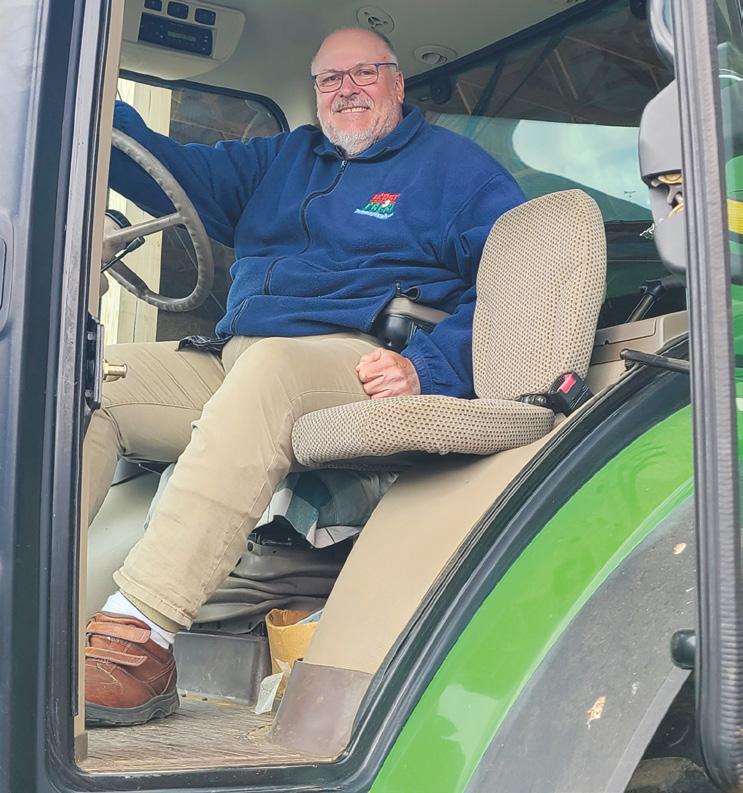
motor vehicle to that of the slow moving vehicle. This provision shall not apply in areas where there are two or more lanes of traffic flowing in the same direction as the slow moving vehicle.
b. For purpose of this section, “slow moving vehicle” means a vehicle affixed with a slow moving vehicle emblem pursuant to subsection (d) of R.S.39:3-24.
c. A person who violates the provisions of this section shall be subject to a fine of not less than $100 or more than $500.
So, can you just pass them?
In my opinion, the answer is that it depends on where you are on the road. Just like any other vehicle, you may only pass a slow-moving vehicle in a passing zone and if you can do it safely. If you cannot see around that vehicle to know if there is oncoming traffic, you should not attempt to pass them.
In a nut shell, people driving farm equipment on public roads often have limited visibility and hearing due to the size and noise of the equipment. Farm vehicles are also less maneuverable than regular cars and move more slowly.
Please slow down and keep your distance. Don’t assume that the farmer can pull over and let you pass. Shoulder conditions may make it unsafe for the operator to pull the equipment to the side of the road.
Also, please do not assume
GardenerNews.com 18 April 2024 Read The Gardener News Online GardenerNews.com
(908) 359-4652 • CentralJerseyNurseries.com
HARDWARE LANDSCAPE MATERIALS NURSERY STOCK
GARDEN CENTER
POWER EQUIPMENT
(Cont. on Page 26)
Tom Castronovo/Photo
Paul Hlubik, owner of Backacres Farms in Chesterfield Township, Burlington County, NJ., gets ready to move a John Deere 8235R farm tractor to a farm down the road from his barns.
In the heart of central New Jersey lies a testament to the fusion of tradition and technology in agriculture: Holland Greenhouses, helmed by the visionary leadership of Casey Jensen Sr. and Jr., representing the third and fourth generations of Dutch tulip growers. This family-run wholesale grower is revolutionizing the industry through hydroponic cultivation and cuttingedge machinery.
Our recent tour of Holland Greenhouses offered a glimpse into the future of farming. From the moment we stepped into the bulb sorting area, it was evident that we were in for an extraordinary experience. Witnessing the lightning speed of the machinery as it sorted and placed bulbs with precision was nothing short of awe-inspiring. The transition from bulb to plant to flower unfolded seamlessly before our eyes, showcasing the efficiency and innovation driving every aspect of the operation.
As we traversed the massive greenhouses, it became clear that technology was at the heart of every process. Computerized systems meticulously measured and monitored every aspect of plant growth, ensuring optimal conditions for each individual specimen. The ability of the machinery to adjust and redistribute nutrients to plants as needed was a testament to the
“Other holidays repose upon the past. Arbor Day proposes for the future.” This is a quote from Julius Sterling Morton, the founder of Arbor Day in the US. Arbor literally translates to tree from its Latin origin. Since its inception in the US in 1872, Arbor Day celebrates the planting, upkeep and preservation of trees.
Morton moved to Nebraska in the mid 1850’s and purchased 160 acres of desolate flat prairie land in Nebraska City. Here he planted a wide variety of trees and shrubs for their many benefits. Being the editor of the state’s first newspaper, The Nebraska City News offered him the perfect platform to tout his knowledge of trees and their life-sustaining contributions. His constant message of tree life hit a chord with readers, many of whom recognized the lack of forestation in their surrounding landscapes. It was a common practice of the Plain Indian tribes to continually burn the grasslands to keep them as such, along with expanding the range of their Bisom lands. This abandoned practice led to a vast, treeless prairie encompassing much of our nation’s breadbasket. As settlers were increasingly populating this region, their permanency of dwellings led to a

USDA Farm Service Agency
By Bob Andrzejczak State Executive Director
Investment in the Future
level of precision achievable through automation.
One of the most striking aspects of the tour was the machinery responsible for trimming flowers. The speed and precision with which it operated, utilizing x-ray technology to measure and adjust before seamlessly bundling the blooms, left a lasting impression. What would take hours for a single person to accomplish was executed in mere moments, highlighting the transformative power of mechanization in agriculture.
Reflecting on the experience, one cannot help but wonder about the broader implications of such innovation. The potential to streamline and mechanize everyday farming operations holds promise for increased productivity and sustainability. While the upfront investment may seem daunting, the long-term benefits in terms

greater need for nearby trees.
Morton was also involved in the Nebraska Board of Agriculture, where he proposed in 1872 a day to encourage Nebraskans to plant trees. The first ever US Arbor Day occurred on April 10, 1872, upon which approximately one million trees were planted. Morton’s writings leading up to this day, coupled with his passion, assured this remarkable success.
Fast forward to nearly 100 years later, in 1970, when President Nixon signed a bill commemorating Arbor Day as a national holiday. What led to this momentous occasion? Harry J. Banker, an arborist from West Orange, New Jersey, teamed up with Ed Scanlon, a nursery man from Cleveland, Ohio, and with the assistance of Harry’s wife, Patricia, petitioned approximately
of production efficiency and land utilization make it a worthwhile endeavor.
In an era where the number of farms continues to decline, embracing technology is not just a choice but a necessity for the survival and growth of agriculture. Simplifying time-consuming tasks through mechanization allows businesses to thrive and flourish, paving the way for a brighter future for our agricultural community.
Looking ahead, the applications of technology in agriculture are limitless. From improving crop yields to reducing labor costs, the potential for innovation knows no bounds. As we eagerly anticipate the next wave of mechanization, it is essential to remember that support and assistance are readily available.
For those interested in exploring the possibilities of technology in agriculture, the Farm Service Agencies offer low-interest loans to
finance the purchase of equipment similar to the machinery systems at Holland Greenhouses. Investing in the advancement of technology is not just an investment in the future of farming, but it is an investment in the continued success and sustainability of our agricultural producers.
In conclusion, let us embrace innovation and technology as we navigate the ever-changing landscape of agriculture. Together, we can cultivate a future where efficiency, sustainability, and prosperity go hand in hand.
Ownership Loans
FSA Ownership Loans offer flexible repayment terms tailored to fit each farmer’s unique situation. Whether it’s a short-term loan or a longer-term commitment, farmers have the freedom to choose what works best for them.
With competitive interest rates, FSA makes sure that farmers have access to financing that won’t break
Tree Notes
By Bert Kuhn
Arbor Day
35 states to push this bill through legislature, establishing Arbor Day as a national holiday. His son, Harry P. Banker, recalls traveling with his parents to the White House to experience the celebration of this proclamation. A lasting tribute is found in the International Society of Arboriculture’s Harry P. Banker Gold Leaf Award for outstanding Arbor Day activities.
The history of Arbor Day is a prime example of how a few motivated people can dramatically impact our environment! Arbor Day is currently celebrated by at least 44 countries and continues to grow.
Why plant a tree? Beyond their beauty, trees create oxygen, are integral in our ecosystems, provide food, cooling and insulating effects, vast by-products, and
the bank. These rates are designed to reflect market conditions, giving farmers a cost-effective option for purchasing land or equipment.
For farmers worried about upfront costs, FSA offers down payment assistance to eligible applicants. This assistance helps lower the barrier to ownership, making it easier for farmers to take that next step.
Unlike some loans, FSA Ownership Loans come with no prepayment penalties. This means that farmers can pay off their loans ahead of schedule without any extra fees, giving them more financial freedom.
Applying for an FSA Ownership Loan is simple. Just reach out to your local FSA office to get started. Loan officers are there to guide you through the process and help you find the loan that’s right for you.
Editor’s Note: Bob Andrzejczak is the State Executive Director of the USDA Farm Service Agency (FSA) in New Jersey. He can also be reached at 609587-0104 during regular business hours. For more information, please visit https://www.fsa.usda.gov/ state-offices/New-Jersey/ sed-biography/index
trees, can increase property values as much as 20%.” (Management Information Services/ICMA.)
carbon sequestering benefits. This explains the current tree planting priorities being widely employed, especially in urban areas, to offset “Heat Island” effects. Please note the following quotes: “Trees properly placed around buildings can reduce air conditioning needs by 30% and can save 20-50% in energy used for heating.” (USDA Forest Service); “The planting of trees means improved air quality, resulting in less runoff and erosion. This allows more recharging of groundwater supply. Wooded areas help prevent the transport of sediment and chemical into streams.” (USDA Forest Service); “The net cooling effect of a young, healthy tree is equivalent to 10 room size air conditioners operating 20 hours a day.” (US Department of Agriculture); and, “Landscaping, especially with
I personally am planning to plant trees on my farm in Harmony Township, Warren County, due to the Ash Tree loss associated with EAB, or Emerald Ash Borer. I plan to use bareroot stock as this will be the most economical. Protection strategies will need to be employed as there are a substantial number of deer. Once the trees establish themselves, and the terminal bud exceeds browse height, they will flourish. I’m planning on using native, proven, hearty species to fill in these voids resulting from the Ash loss.
Our congregation, the NJAISA, is once again teaming up with the NJNLA in Camden to celebrate 2024 Arbor Day. How will you celebrate Arbor Day? The absolute best way is planting a tree!
Editor’s Note: Bert Kuhn is President of the New Jersey Chapter of the International Society of Arboriculture and CO/Owner of Action Tree Service (# NJTC768009), based out of Watchung, NJ. He can be reached at 908756-4100
GardenerNews.com April 2024 19
NJ Licensed Tree Expert (LTE) Licensed Tree Care Operator (LTCO)
NRCS-NJ Accepting Applications for Joint Chiefs’ Landscape Restoration Partnership
The United States Department of Agriculture’s (USDA) Natural Resources Conservation Service (NRCS) in New Jersey is accepting applications for forest management activities on private lands for the purposes of reducing wildfire risk in municipal watersheds and the wildland-urban interface, implementing carbon defense activities, improving habitat for threatened and endangered species, and mitigating the effects of Southern pine beetle, through the New Jersey Pine Barrens Joint Chiefs’ Landscape Restoration Partnership.
Landowners located in the Pinelands region, which covers portions of Atlantic, Burlington, Camden, Cape May, Cumberland, Gloucester, and Ocean counties, are encouraged to contact their local service center to apply. While NRCS accepts applications for programs yearround, landowners should apply by May 31, 2024 to be eligible for this funding cycle.
The Joint Chiefs’ Landscape Restoration Partnership is one of 14 projects selected across the U.S. bringing together agricultural producers, forest landowners, and National Forest System lands to improve forest health using available Farm Bill conservation programs and other authorities.
The Joint Chiefs’ Landscape Restoration Partnership enables the Forest Service and NRCS to collaborate with agricultural producers and forest landowners to invest in conservation and restoration at a large enough scale to make a difference. Working in partnership, and at this scale, helps reduce wildfire threats to communities and critical infrastructure, protect water quality and supply, and improve wildlife habitat for at-risk species.
Initially funded in Fiscal Year 2023, this is the second year of the three-year project in which landowners work with local USDA experts and partners to apply targeted forestry management practices on their land, such as thinning, hazardous fuel treatments, fire breaks, and other systems to meet unique forestry challenges in their area.
To apply, contact an NRCS representative at your local USDA Service Center. You can find your local Service Center at www. farmers.gov/service-locator. Additionally, on farmers.gov, you can create a secure account, apply for NRCS programs, electronically sign documents and manage your conservation contracts.
Planting Seeds of Change: Bobcat Gives Back to Five Parks Around the Country
Bobcat has partnered up with the National Recreation and Park Association (NRPA) to create a greener future by awarding five $50,000 grants to support park restoration. The five grants have been awarded to the communities of the city of Stonecrest, Georgia; Davidson County Parks and Recreation in Lexington, North Carolina; the city of Buffalo, New York; San Antonio River Authority of San Antonio, Texas; and the City of Auburn Parks, Arts & Recreation of Auburn, Washington.
With the help of local Bobcat dealers, a variety of restoration, sustainability and enhancement projects are being completed to create more sustainable environments, building a stronger community and engagement outdoors.
Parks and community spaces provide opportunities for outdoor enjoyment, recreational activities and more. Like Bobcat® equipment, those spaces help people accomplish more. Together with the NRPA, Bobcat has aligned its mission of supporting communities by improving their environment and the outdoor spaces community members enjoy.
With a mission to improve and renovate outdoor spaces at five different parks around the country, Bobcat is determined to help the NRPA bring local communities together for outdoor recreation and all the benefits it brings. Learn more at https://www.bobcat.com.

In the Chef’s Corner
By Andy Lagana Chef
Italian Easter Pizza
Hello readers! This month, I’m sharing a recipe that has been in my family for generations. Nanny’s Pizza Gain (also known as Pizzagaina, Pizza Rustica, or Pizza Chiena) is an Italian Easter Pizza unlike any pizza you have ever tasted!
Gather 11 large eggs, 12 ounces sweet Italian sausage (3 sausage links), 12 ounces spicy Italian sausage (3 sausage links), 10 cups cold water plus more for eggs, 1 1/2 pounds hamcubed, 1/4 pound of capicola - cubed, ¼ pound soppressata - cubed, ¼ pound mortadellacubed, 1 teaspoon sweet paprika, 1 cup ricotta, 1/2 cup vegetable shortening or lard (or unsalted butter), 2 cups all-purpose flour, 1 teaspoon baking powder, 2 teaspoons kosher salt - divided, 10 ounces lowmoisture whole-milk mozzarella cheese - shredded (about 3 cups), 7 ounces sharp provolone cheesegrated on large holes of box grater (about 2 cups), 1/2 cup roughly chopped fresh flat-leaf parsley, 1/2 teaspoon black pepper and cooking spray.
Fill a large bowl with ice water. Place six eggs in a medium pot and add cold water to cover by an inch. Bring to a boil over medium-high. Immediately remove from heat, then cover and let stand for 12 minutes. Transfer the eggs to prepared ice water letting them cool 10 minutes. Peel the eggs and cut them lengthwise into quarters, and again into 1/4inch pieces. Then, transfer the egg pieces to a small, covered bowl and refrigerate until use.
While the eggs cook, pierce each sausage casing with a paring knife so the fat renders as they cook. Place 10 cups of cold water, sausages and paprika in a large pot. Bring this mixture to a boil over medium heat. Reduce the heat to medium-low to maintain a simmer. These should simmer until a thermometer inserted into the sausage’s thickest portion
registers at 160°F, about 30 minutes.
Remove ingredients from the heat. Using tongs, remove sausages from the pot and set them aside until cool. Ladle one cup of cooking liquid from the pot (along with any fat on top) into a medium-size metal bowl. Then, refrigerate until chilled and the fat solidifies at the top of the bowl. Discard the remaining cooking liquid in the pot. Once the meat is cooled, remove and discard the sausage casings. Cut the meat roughly into 1/4-inch cubes. Cover and refrigerate it until ready to use.
When the cooking liquid has chilled long enough for the fat to separate, remove it from the refrigerator. Using a large spoon, skim off the fat and place it in a measuring cup. Add as much vegetable shortening to the skimmed fat as needed to measure 1/2 cup total. Set this and the remaining chilled cooking liquid aside.
Beat the flour, baking powder and 1 teaspoon salt in a stand mixer fitted with a paddle attachment on medium until just combined, about 20 seconds. Slowly beat in the reserved 1/2 cup fat mixture (1 tablespoon at a time). Reduce the mixer speed to low and add 1/2 cup of the reserved chilled cooking liquid. Beat until well incorporated and with the dough looking slightly shaggy, up to two minutes. Discard the remaining chilled cooking liquid.
Next, transfer the dough to a clean work surface. Knead it using the palms of your hands until well incorporated. The dough should be soft but not sticky and hold together in a ball. Wrap the dough ball in plastic wrap and let it rest at room temperature for one hour. The dough may be tightly wrapped in plastic wrap and stored in the refrigerator for up to two days. Let it come to room temperature before using.
Whisk together four of the
uncooked eggs in a large bowl. Add the sausage, ham, mortadella, capicola, soppresatta, egg pieces, mozzarella, provolone, ricotta, parsley, pepper, and one teaspoon of salt to the eggs, then set aside.
Preheat the oven to 375°F with the rack in its lowest position. Coat a 10-inch spring form pan (2” deep) with cooking spray. Unwrap the dough on a clean, dry work surface. Divide the dough evenly into three pieces. Roll two of the dough pieces together into a 16-inch round. Carefully ease the dough round into the pan, trying not to stretch it too much, then gently press dough into the pan corners. Some of the dough should hang over the pan sides by 1/4- to 1/2-inch. Spread the meat-egg mixture evenly over the dough in the pan, packing it in firmly but gently. Whisk the remaining egg in a small bowl. Using a pastry brush, brush the egg wash on the exposed edges of the bottom piece of dough. Reserve remaining egg wash. Roll out remaining dough piece into a 12-inch round. Place the dough round on top of meategg mixture in pan. Trim the edges of dough with scissors or a sharp paring knife so there’s a 1/2-inch overhang all around. Gently roll the edge over on itself, the bottom dough over the top, toward the middle of the pan until it’s tightly sealed. It should look like a rope and sit inside the edges of the pan (not on top of the rim).
Brush the remaining egg wash over the pie top. Make four 1” slits into the pie top. Place the pie on a large rimmed baking sheet and bake until the top is golden brown and a thermometer inserted in its center registers 150°F, about 1 ½ hours. Transfer the pie to a wire rack and let it cool for 15 minutes. Remove the pie from pan and let it cool on a wire rack for two hours. You can serve the pie warm or chilled, cut into wedges. Enjoy with a classic Valpolicella.
Editor’s Note: Andy Lagana is a Chef at Crystal Springs Resort in Hamburg, Sussex County, N.J. For more information on its culinary program, visit www.CSResort.com.
GardenerNews.com 20 April 2024







GardenerNews.com April 2024 21
NORTHEASTERN ASSOCIATION OF STATE
The Northeastern Association of State Departments of Agriculture convenes the following 10 states: Connecticut, Delaware, Maine, Massachusetts, New Hampshire, New Jersey, New York, Pennsylvania, Rhode Island, and Vermont.
CONNECTICUT DEPARTMENT OF AGRICULTURE Agricultural Businesses Encouraged to Apply to Exhibit in CT Building at The Big E
The Connecticut Department of Agriculture (CT DoAg) is now accepting vendor applications for the agricultural booth spaces inside the Connecticut Building at the 2024 Big E. The Connecticut Building is one of six New England buildings on the Avenue of the States at The Big E in West Springfield, MA. The 17-day annual event will take place September 13-29, 2024, offering farms, small agricultural businesses, and agricultural nonprofit organizations based in Connecticut the opportunity to market their products and promote their services.
“The visibility of participating in the CT Building at The Big E enables Connecticut agricultural businesses to reach more than 1 million fairgoers each year,” said Agriculture Commissioner Bryan P. Hurlburt. “This exposure has increased sales both during, and after the fair for participating entities and led to greater consumer awareness regionally of CT Grown farm products available for purchase.”
Eligible entities include agricultural businesses, non-profits, and other entities with an agricultural mission to showcase the diversity of Connecticut agriculture to over one million attendees who come through the Connecticut Building. Connecticut Day will take place on Wednesday, September 18, 2024, and Harvest New England Day will be held on Friday, September 27, 2024.
The application deadline for the agricultural spaces is March 29, 2024, at 4:00 p.m. Visit www.ctgrown.gov for more information.
NEW YORK DEPARTMENT OF AGRICULTURE
FFA Chapters and Membership Continue to Grow with 200 Chapters Across N.Y. State
During National FFA Week, Governor Kathy Hochul announced significant growth in New York State’s agriculture education and FFA Programs. Since 2016, the number of agricultural teachers has grown to 412 in 2023, a more than 75 percent increase from 2016. In addition, New York’s FFA chapters and membership continue to grow, with 36 new FFA chapters created since 2022 and 89 since 2016, making for a total of 200 FFA chapters established across New York today. The Governor’s 2024 State of the State and FY 2025 Budget both prioritize agricultural education, with the creation of a youth agriculture leadership conference and the dedication of $1.25 million to support the FFA, an increase of $250,000 from last year.
“As a former 4-H kid, I know firsthand how important agricultural education is to developing a generation of leaders that understand where our food comes from, value the work of our farmers, and are committed to supporting our agricultural communities,” Governor Hochul said. “There are endless opportunities for our students to build a career in agriculture, from farming to food science, bio-technology, engineering, veterinary medicine, and so much more. New York will continue supporting our passionate educators and grow these critical programs across the state.”
The increase in agricultural teachers, through programs such as Cornell University’s Agriculture Education and Outreach Program, New York Agriculture in the Classroom, and the New York State FFA Association, is allowing more schools and students to participate in a formal agricultural curriculum, providing a direct boost to the pipeline of students who will go on to enter into the agricultural industry as a future career.
Alongside this growth in teachers, the number of FFA charters and members has also increased. With 200 chapters established in 53 of New York’s 62 counties, there are now nearly 12,000 FFA members in New York State, an increase from 9,300 in 2022. In 2016, State Agriculture Commissioner challenged the FFA to increase its number of charters across the State by 100; the FFA is nearing that goal with 89 created since then.
The New York FFA Association is a youth organization that helps middle and high school students become leaders in a variety of career fields, including agriculture. In the FY 2024 Budget, $2 million was invested to support the New York FFA, Association of Agricultural Educations, and New York Agriculture in the Classroom, and $50,000 was allocated to support the Minorities in Agriculture, Natural
Resources, and Related Sciences (MANRRS) program.
The Governor’s 2024 State of the State address and FY 2025 Budget builds on this work, with the Governor continuing to prioritize investments in agricultural education to support workforce development and ensure that agriculture remains a viable industry in New York State. She has proposed a youth agriculture leadership conference, increased support for the FFA in the Executive Budget by $250,000 for a total of $1.25 million and dedicated $1 million to support the New York Agriculture in the Classroom program and increase the number of certified agricultural educators in the state. In addition, $250,000 is included in the Executive Budget in support of Urban Agricultural Education and $50,000 for the MANRRS program. Together, these programs help meet the growing demand for agricultural education across New York.
National FFA Week, which is celebrated from February 17 – 24, honors the positive impact that FFA and agricultural education programs have on students across New York and the nation.
State Agriculture Commissioner Richard A. Ball said, “Our agricultural teachers and FFA leadership are so passionate about building the future of this industry. They are the driving force behind these powerful programs that are helping our young people to learn about the industry and obtain the skills they need to be successful in agriculture and its related industries. When I look at our schools’ ag programs and our FFA students, I’m optimistic and excited about the future of our industry. I want to thank our existing ag teachers and FFA leaders for their dedication and welcome our newest teachers, who are embarking on this significant work of educating our young people. I also want to thank our Governor, and our Legislature, for their continued support of these critical programs that are making a lasting impact on agriculture and will continue to for generations to come.”
Administered by Cornell University, NY FFA develops premier leadership, personal growth and career success through activities and opportunities nationwide. FFA was founded by a group of young farmers in 1928. Their mission was to prepare future generations for the challenges of feeding a growing population. They showed that agriculture is more than planting and harvesting – it’s a science, it’s a business and it’s an art.
FFA continues to help the next generation rise up to meet challenges by developing their own unique talents and exploring their interests in a broad range of career pathways. Learn more about NY FFA at www.nysffa.org.
GardenerNews.com 22 April 2024
VERMONT DEPARTMENT OF AGRICULTURE
Join the Vermont Pavilion at the 2024 Summer Fancy Food Show this June
The Vermont Agency of Agriculture, Food & Markets invites Vermont specialty foods businesses to showcase their products at the 2024 Summer Fancy Food Show in New York City, from Sunday, June 23rd through Tuesday, June 25th.
The Summer Fancy Food Show is one of the premier business-to-business trade shows for specialty food products, attracting buyers, distributors, and wholesalers from across the globe each year. Exhibitors at this show benefit from three days of engaging discussions with leading buyers, industry peers, and influential press, offering invaluable opportunities for business growth and brand exposure.
This is an ideal event for established businesses with prior trade show experience. Businesses should be prepared to fulfill large-volume orders and should be poised to expand into new domestic and/or international markets. Joining the Vermont Pavilion provides businesses with enhanced exposure and allows them to fully benefit from the strength of the Vermont brand. Vermont’s reputation for high-quality products attracts special attention from buyers throughout the show.
The Vermont Pavilion offers up to ten 10’ x 10’ booths, with options available for larger spaces. Booths are priced at $44 per square foot. Space allocation is on a firstcome, first-served basis, and availability is limited.
For more information and to secure your spot, please contact Trevor Lowell at trevor. lowell@vermont.gov.
For more information about the Summer Fancy Food Show, visit: https://www. specialtyfood.com/fancy-food-shows/ summer/
OF AGRICULTURE
NEW JERSEY DEPARTMENT OF AGRICULTURE
Salem County Vegetable, Grain Grower New Jersey’s 2024 Outstanding Young Farmer
Byron DuBois, a Salem County vegetable and grain grower, has been chosen as New Jersey’s 2024 Outstanding Young Farmer by the New Jersey State Board of Agriculture. DuBois and his wife, Karen, are also one of 10 finalists for the 2024 National Outstanding Young Farmer Award, which will be awarded at the National Outstanding Young Farmer Congress on Feb. 15-18 in Ferndale, Wash. They were recognized at the Joint State Agricultural Convention Banquet last week.
“The DuBois family has a storied history in New Jersey’s agricultural industry and Byron has done exemplary work in continuing a generationslong legacy,” New Jersey Assistant Secretary of Agriculture Joe Atchison III said. “Byron’s ability and willingness to use innovative, efficient, and environmentally friendly practices has allowed Spring Brook Farms to continue as one of the outstanding operations in the State.”
Byron is a seventh-generation farmer and learned many intricacies of the business from his father, Henry. By the time he was a teenager, Byron was operating equipment for spinach harvest, combining grain, and harvesting green beans. In his high school years, Byron played a significant role in purchasing equipment as his parents would drive him to dealers to inspect machinery or equipment before purchasing. Byron then attended Delaware Valley College where he studied Agricultural Business Management. It was there that he met other students with agricultural backgrounds and learned about different methods of farming.
“All I have ever wanted to do is farm,” Byron said. “It runs through my veins, and I couldn’t imagine doing anything else as it is a passion and a love that I get to experience everyday of my life with my family by my side.”
The primary crops grown on the more than 4,000 acres owned by Byron and his father include carryover spinach, spring spinach, fall spinach, winter spinach, sweet corn, tomatoes, field corn, soybeans, and wheat.
“Every season creates a new opportunity to start fresh, plant seeds to grow crops and nurture them through harvest time,” Byron said. “That hard, honest, and sometimes thankless work that goes into every season provides immeasurable rewards that fuel my appetite for farming.”
Throughout the years, Byron has led the farm’s efforts to become more efficient in many facets of the operation. This includes upgrading equipment for quicker spinach and tomato harvests, and using GPS technology for more precise planting, harvesting and treatment methods. The farm also uses detailed mapping information to find specific
soil types in fields, which in turn has led to more economical use of fertilizers and irrigation.
The DuBois farm participates in the USDA’s Conservation Reserve Enhancement Program (CREP) and Natural Resources Conservation Service Irrigation Water Management Programs that have helped reduce soil erosion allowing water to drain from fields without soil disturbance.
Byron also points out that Karen does more than her share to help the farm’s success, even though she is a full-time teacher at the local elementary school.
“Karen is an incredibly supportive wife in every aspect,” Byron said. “She is always willing to lend a hand on the farm, whether it is helping my mother prepare meals for the team working late, working on the tomato harvester, driving the dump cart for harvesting spinach, moving equipment around or just being there when I need her.”
The DuBois farm is active in the community. In addition to volunteering the use of its water tanker trailer at the Salem County Fair each year, it has hosted a Salem County Emergency Management farm safety event, and drills for local fire departments where they can practice by cutting apart old farm equipment. The farm is also a corporate sponsor for the local Little League and supports the Salem County 4-H Club.
Byron joins his father in winning this award, as Henry DuBois was the New Jersey Outstanding Young Farmer in 1983.
The Outstanding Young Farmer (OYF) program is the oldest farmer recognition program in the United States, with the first group of national winners selected in 1955. The goals of the OYF program are to foster better urban-rural relations through the understanding of farmers’ challenges, as well as the appreciation of their contributions and achievements; to bring about a greater interest in farmers/ranchers; and to help build an urban awareness of the farmers’ importance and impact on America’s economy.
The OYF program encourages a greater interest in agriculture and recognizes local citizens’ contributions. The National OYF program is sponsored by Deere & Company, administered by the Outstanding Farmers of America Fraternity, and supported by the National Association of County Agricultural Agents, the National Association of Conservation Districts, and the US Junior Chamber of Commerce.
For more information on the State’s Outstanding Young Farmer program, visit: www. nj.gov/agriculture/about/sba/cover.html or contact Assistant Secretary/Marketing and Development Director Joe Atchison at joe.atchison@ag.nj.gov.
GardenerNews.com April 2024 23 DEPARTMENTS
NEWS
Read the Gardener News online at GardenerNews.com




Growing Gardeners
By Diana Dove Environmental Educator
Certifying Wildlife Habitats with all ages in a County-wide Challenge!
I’m excited to see the interest in one county where many people, both youth groups and adults, are coming together with a goal to certify several hundred wildlife habitat gardens within their own county! As Earth Day approaches on April 22, it’s a perfect time to highlight an example of community cooperation to create a healthier environment.
The Warren County, New Jersey Board of County Commissioners has challenged its residents to create healthy wildlife habitat gardens to meet the National Wildlife Federation certification requirements classified as a Community Wildlife Habitat. To achieve this certification, a wildlife habitat must be created or restored in the community, with education and outreach.
said, “In the northwest section of New Jersey, there is a county-wide effort to educate new or experienced gardeners, children of all ages, homeowners, and any source of sites that have garden space. There are numerous wildlife and pollinator garden certifications that may be described, however this county-wide challenge involves the National Wildlife Federation (NWF) Certification. It has been initiated in a unique way.
certified within each municipality to reach the community certification goal. Education and outreach efforts are underway to encourage other towns to join the movement, adding to the growth of the county’s WildlifeFriendly Community.


A recent press release stated, “The goal is to help the county become a healthier and more wildlife-friendly community by encouraging residents to voluntarily create wildlife habitats at various sites like backyards, schools, businesses, places of worship, community gardens, and parks. Anyone can volunteer to make their space more sustainable for wildlife.”
How fortunate I am to live in Warren County, where I attended the Washington Borough Public Library program with two presenters: Josephine Noone of the Washington Borough (NJ) Green Team and Warren County Park Naturalist, Jennifer CorreaKruegel. They shared a slide show from the National Wildlife Federation that outlined the requirements for a wildlife habitat and gave examples of what to plant. Local resources for native plants were shared emphasizing purchasing plants free of neonicotinoids.
Jennifer Kruegel, who represents the Warren County Land Preservation Dept., explained what is behind a surge of interest in educating the public about wildlife habitat gardens. She
The Warren County “Commissioners’ Conservation Challenge” is the result of the newly established Environmental Advisory Committee which began in 2022. It was tasked with representing municipalities throughout Warren County to provide opportunities for townships to get involved with environmental conservation.
The challenge involves creating habitat for wildlife and becoming certified by the NWF. To do this, individuals, schools, institutions, or businesses, will need to provide a garden with food, water, cover, and a place for wildlife to raise young. Food could be native plants, water could be a birdbath, and cover could be a bird house or a bat box. Following sustainable gardening practices with a rain garden or compost bin provide an advantage.
Register at: https://nwf.org/Certify
By providing people with the tools to create a more wildlife-friendly habitat, we can create a domino effect. When native plants are allowed to thrive, native insects will feed off them, then native birds and other wildlife will eat the insects.”
Josephine Noone explained that the first three municipalities in Warren County to register as a Community Wildlife Habitat include: Washington Borough, and Hope and Allamuchy Townships. Based on population, a specified number of gardens must be
As founder of the Karen Nash Memorial Butterfly Garden, located at Memorial Elementary School in Washington Borough, I registered our school pollinator garden as a Certified Schoolyard Habitat, which is part of the program, requiring a garden to provide food, water, cover, and places to raise young. The Schoolyard Habitat certification sign reads, “This site is recognized for its commitment to sustainably provide the essential elements of a wildlife habitat and provides students with a place to learn outdoors and connect with nature.”
For details go to: nwf.org/schoolyard
Youth benefit from wildlifefriendly gardening activities as they witness connections between living plants and wildlife, helping them understand the importance of the role that people play in protecting habitats. It’s critical for youth to become involved. For the sake of a healthy environment, these children and teens are the decision makers of the future who gain experience learning about the value of natural resources while gardening.
They love nature and become protectors of pollinators and wildlife habitats, inspiring all ages. It’s motivating to become involved in a garden that they helped grow right in their own backyard, school, or within their community. Most importantly, gardening in a wildlife habitat creates an environment for healthier living. Certifying a municipality and county as a Community Wildlife Habitat brings youth and adults together and teaches Growing Gardeners life lessons to share for the generations ahead.
Editor’s Note: Diana is an Environmental Educator with award-winning programs for all ages who has been teaching since 1975. She can be reached at dianadove13@gmail.com She currently co-teaches, “Wildlife & Litter” programs
GardenerNews.com 24 April 2024
with her husband Mike that are free to NJ groups when sponsored by Clean Communities. This includes guided nature walks, pond studies, education booths at town festivals, and outdoor programs for youth & adult garden clubs, schools, camps, libraries, and service organizations with a message about not littering. She is a former Sr. Naturalist for Somerset Co. Parks. In October, 1996 Diana founded a schoolyard, wildlife habitat garden at Memorial School in Washington Boro, Warren County, NJ. Please ‘Like” the FB page of the Karen Nash Memorial Butterfly Garden. Diana volunteers as Youth Chair on the Bd of the Garden Club of NJ and is a First Place National Winner of the NGC Youth Leader Award. She has a BS in Forestry & Wildlife Mgt, with a concentration in Biology, plus a BA in Communications from Va Tech. Celebrate Mother’s Day with us! Celebrate Mother’s Day with us! *Award Winning Wine List* Seafood, Steaks, Pasta. Are Our Specialties Daily Lunch & Dinner Specials Family Style Meals To-Go Curbside Pickup and Takeout 601 Grand Central Avenue (Rt. 35 North) Lavallette, NJ | 732-793-4447 Order Online
Toro Named to Fortune’s List of World’s Most Admired Companies
Toro, a leading global provider of solutions for the outdoor environment, has been recognized by Fortune as one of the World’s Most Admired Companies for 2024. Toro ranked fifth in the construction and farm machinery category.
“We are honored to be recognized among the world’s most highly regarded and respected companies,” said Richard Olson, chairman and chief executive officer. “To be included in such prestigious company reflects our unwavering commitment to excellence, innovation and value creation for our stakeholders. Behind this achievement is a team of exceptional individuals whose hard work and dedication have set us apart. We collectively celebrate this honor across our organization, and I would personally like to express my sincerest appreciation for the role our global employees and partners have played in achieving this recognition.”
The World’s Most Admired Companies list by Fortune is a comprehensive ranking that evaluates companies across various industries based on key attributes such as innovation, social responsibility, quality of management, and global competitiveness. Toro’s consistent dedication to these principles has earned it a place among the world’s most admired organizations.
To determine the companies with the strongest corporate reputation, Fortune partnered with Korn Ferry to conduct surveys among executives, directors and analysts who assess and rate enterprises within their own industries. The 2024 list recognized 660 companies across 29 countries and 52 industries.
Toro continues to be recognized for fostering a culture characterized by trust, integrity and unmatched customer care – recently earning distinctions as one of the World’s Most Trustworthy Companies and the Most Trustworthy Companies in America for 2023 by Newsweek.
With roots dating back to 1914, Toro is a leading worldwide provider of innovative solutions for the outdoor environment including turf and landscape maintenance, snow management, rental and construction equipment, and irrigation solutions. Through a strong network of distributors, dealers, retailers and rental stores in more than 125 countries, Toro helps customers care for golf courses, sports fields, public green spaces, commercial and residential properties, construction sites and agricultural operations. More at: www.toro.com.
Love Thy Farmer and All Agricultural Producers
(Continued from page 18)
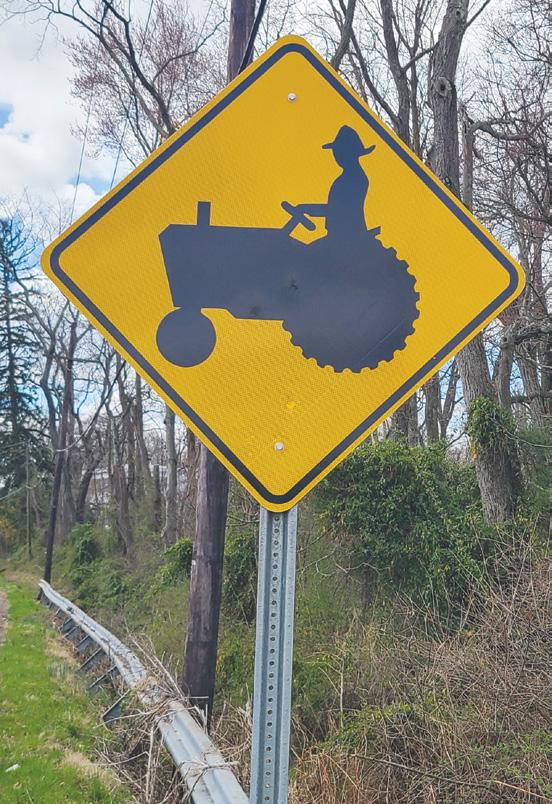
that a farm vehicle that pulls to the right side of the road is going to turn right or is letting you pass. Due to the size of some farm implements, the operator must execute wide left-hand turns.
I have lots of friends who are farmers and agricultural producers. Keep Them Safe! Please be a responsible and courteous driver. It could save your life and the life of one of my friends.
Editor’s Note: Tom Castronovo is executive editor and publisher of Gardener News. Tom’s lifelong interest in gardening and passion for agriculture, environmental stewardship, gardening, and landscaping, led to the founding of the Gardener News, which germinated in April 2003 and continues to bloom today. He is also dedicated to providing inspiration and education to the agricultural, gardening, landscaping, nursery, and outdoor living communities through this newspaper and GardenerNews.com.



GardenerNews.com 26 April 2024 Full Moon April 23, 2024 Eastern Daylight Savings The Premier Gardening Monthly Newspaper Number 252 Published Monthly RESERVE AD SPACE Website: www.GardenerNews.com E-Mail: Mail@GardenerNews.com Staff Executive Editor/Publisher ..... Tom Castronovo Art Director ................. Susan F. Kessel Advertising Tom Castronovo Gardener News is published monthly by Gardener News, Inc. 16 Mount Bethel Road #123, Warren, NJ 07059 The Gardener News invites correspondences on gardening subjects of interest. Gardener News, Inc, and its Publisher reserve the right to accept, refuse, or discontinue any editorial or copy, and shall not be liable to anyone for printing errors, misinformation or omissions in editorial or copy. The information contained in articles herein represents the opinions of the authors and, although believed to be accurate and complete, is not represented or warranted by Gardener News, Inc. to be accurate or complete. All advertising is subject to the Gardener News advertisement rates, and must be PAID IN FULL at time of submission. Publisher reserves the right at its absolute discretion, and at any time, to cancel any advertising order or reject any advertising copy whether or not the same has already been acknowledged and/or previously published. In the event of errors or omissions of any advertisement(s), the newspapers liability shall not exceed a refund of amounts paid for the advertisement. NOTE: All editorial, advertising layouts and designs and portions of the same that are produced and published by Gardener News, Inc., are the sole property of Gardener News, Inc. and may not be reproduced in any form unless written authorization is obtained from the publisher. POSTMASTER: Send all address changes to: Gardener News, 16 Mount Bethel Rd - #123, Warren, NJ 07059. (c) 2024 Gardener News, Inc. April 2024 Contributing Writer Hubert Ling April 2024 Columnists Tom Castronovo Todd Pretz Gail Woolcott Andrew Bunting Brian Schilling Peter Melick Bob Andrzejczak Bruce Crawford Andy Lagana Joe Atchison III Bert Kuhn Diana Dove Advertise in Gardener News Please visit www.GardenerNews.com and click on the Advertising Link in the center of the Navigation Bar to view our Media Kit. We can be contacted through our Contact Us Form, also on the Navigation Bar. Thank you!
Tom Castronovo/Photo
A farm tractor sign warns drivers that agricultural vehicles, such as tractors, regularly cross or use the road at low speed.

GardenerNews.com April 2024 27 4 Coddington Rd. Whitehouse Station, NJ 08889 908.534.7710 www.HionisGreenhouses.com & Garden Center Buy Direct From One Of New Jersey’s Largest Growers Of Plants & Flowers! 287 202 206 202 206 202 Hunterdon Somerset North Branch Bridgewater Somerville 28 22 4CoddingtonRd. Oldwick Solberg Airport Lamington Pluckemin Raritan Whitehouse Station Oldwick Rd. LamingtonRd. OldYorkRd. ReadingtonRd. 78 78 Six Acres Under Glass/Garden Center Tropical Plant and Succulent Headquarters Thousands to choose from!
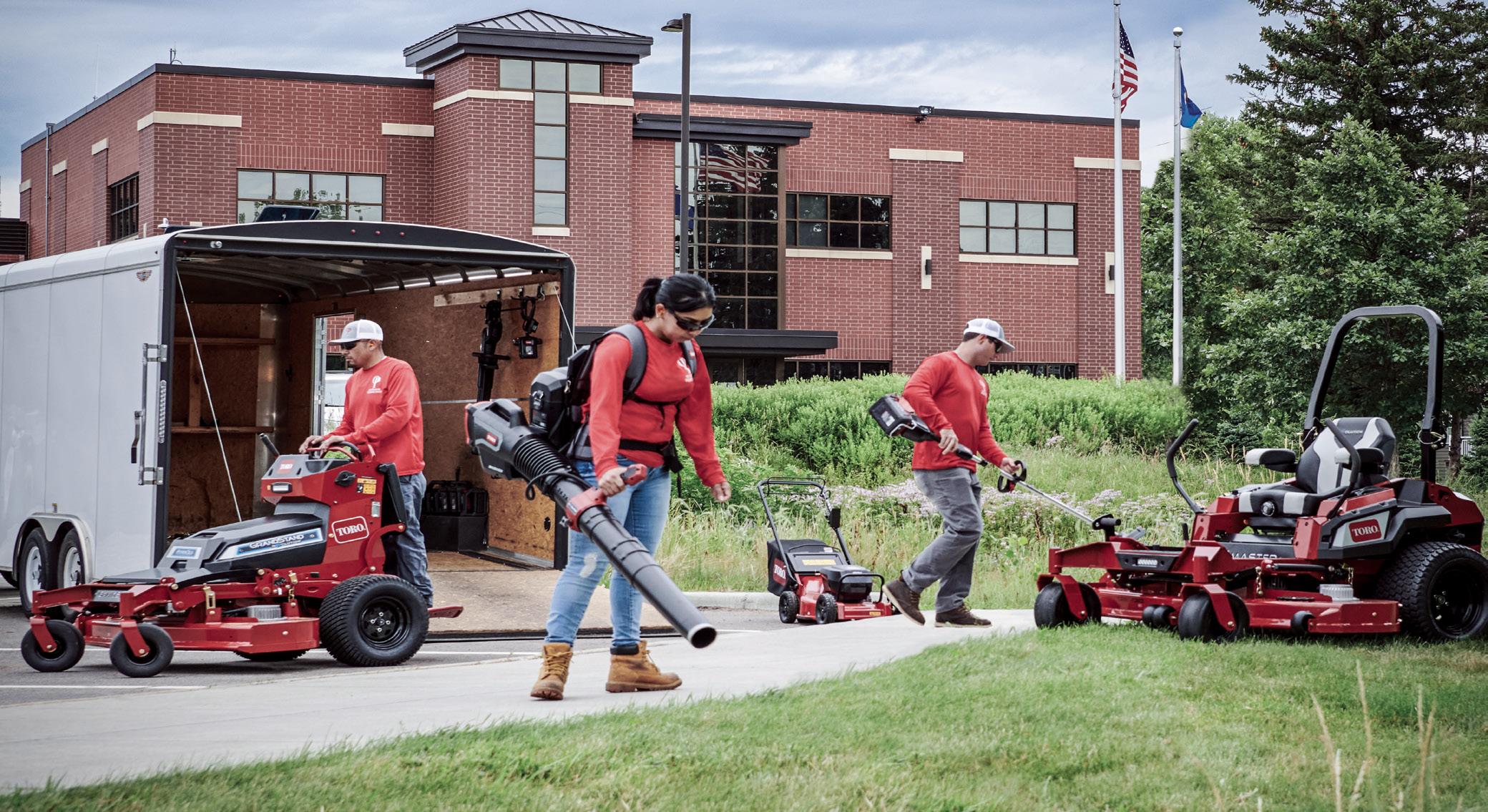
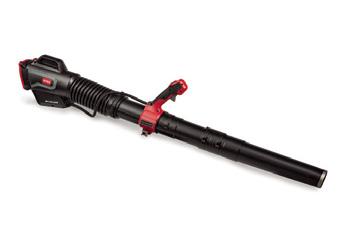



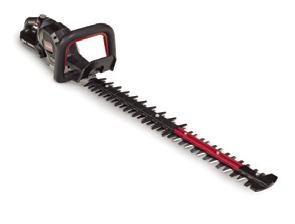


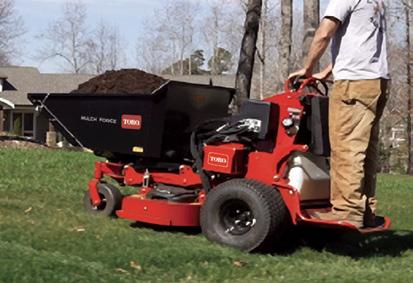
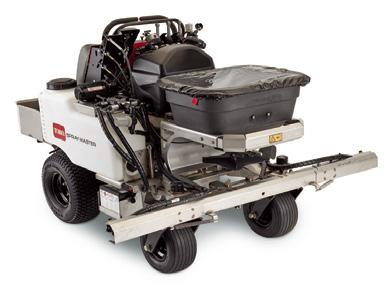

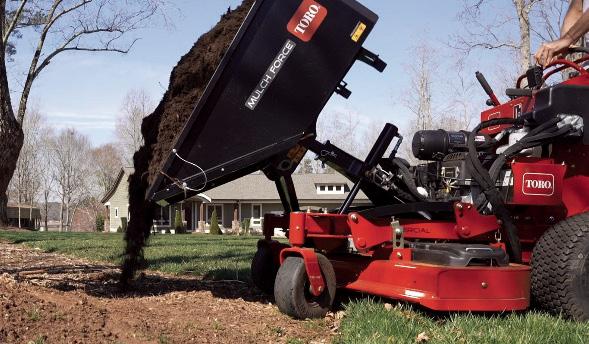


GardenerNews.com 28 April 2024 GRANDSTAND® MULTI FORCE™ WITH MULCH DUMP ALL-SEASON USE A variety of attachments and accessories such as Mulch Dump, Pro-Force blower, snow thrower, power broom, tine rake, dethatcher and BOSS snow blade all provide the ultimate in productivity. REVOLUTION HANDHELD PRODUCTS ALL DAY PERFORMANCE The fully interchangeable 60V Max* Flex-Force battery system powers the entire line of Revolution commercial grade handheld tools. The backpack, available as a power source for the leaf blower, string and hedge trimmers, and is built for comfort and ready to keep jobs moving all day. GRANDSTAND® STAND-ON MOWERS CUSHIONED SUSPENSION Flex-Ride operator platform suspension self-compensates for operators of all sizes, resulting in less fatigue and higher productivity throughout the day. TRACTION & HANDLING A wide stance and optimal balance enhance hillside stability and control. 36”-72” TURBO FORCE ® CUTTING DECKS 96” TURBO FORCE ® CUTTING DECKS Z MASTER 7500-G SERIES ZERO-TURN PRODUCTIVITY TO A NEW LEVEL Impressive 96” wide cutting deck folds to 75” to fit in most trailers. Vented hood keeps the engine cool with direct air induction from the top. Comes standard with Horizon Technology to help choose the right operating mode for mowing conditions. See your local servicing Toro dealer at Toro.com/local PROLINE™ MID-SIZE MOWERS MOWING MUSCLE Reliable Kawasaki engines drive .204” blades for a gorgeous, professional cut. NO-HASSLE SULKY 2-wheel sulky rotates 360º and folds away when not in use; no need to remove for trailering! 36”-60” CUTTING DECKS SPRAYMASTER® STAND-ON TURF RENOVATION Dual Smart Hour Meters and Lean-to-Steer Provide Precision Dispersement White Tanks Simplify Fuel Level Monitoring TURFMASTER® HDX 30” WIDE AREA WALK POWER MOWER Commercial-Grade Kawasaki® Engine Larger, More Powerful Kohler Engine Available Spin-On Oil Filter & Dual Element Air Filter CHARGED BY R EV OLUTION COMPLETE LINEUP INCLUDES GrandStand Stand-On Mowers Z Master Zero Turn Mowers 60V Heavy-Duty 21” Walk Behinds 60V Commercial Handheld Tools NEW! ALL ELECTRIC. ALL DAY POWER. Learn more at Toro.com/revolution
 By Tom Castronovo Executive Editor/Publisher Gardener News
By Tom Castronovo Executive Editor/Publisher Gardener News





















































































